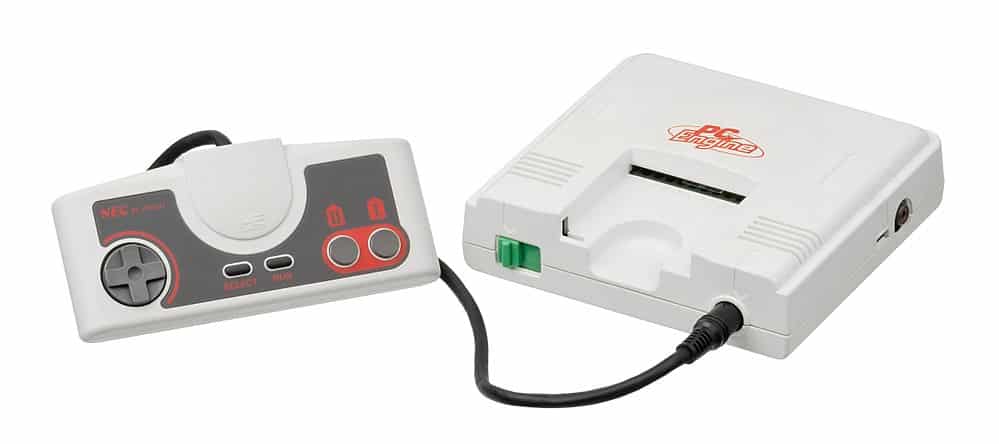The PC Engine is one of the great unknowns in the West, a video game console belonging to the fourth generation of video game consoles, today considered retro and manufactured by Nippon Electronics Components (NEC) which has an abysmal video game catalog and an infinity of of versions and models, forming a whole universe in itself within video games. In its beginnings, it was able to face the almighty Famicom and later the powerful Super Nintendo and Mega Drive, emerging gracefully and victorious in many cases, thus becoming an icon of the glorious era of 16-bit in Japan.
The PC Engine is a console so localized in the Japanese country, that although there are western versions of the system such as the TurboGrafx 16, the fact that they are not “region free” consoles (the HuCards) as well as having two catalogs so different and the difference in reaped success, means that in practice we can treat them as different systems, being the Japanese system the one that made history. So let’s get to know the cult console that every fan of Japan and the 90’s should have in their home, NEC’s PC Engine.
| COMPANY: | NEC |
| CONSOLE GENERATION: | 4TH GENERATION OF CONSOLES |
| RELEASE DATE: | October 30, 1987 in Japan. |
| GAMES CATALOG: | 682 video games (HuCards + CD-ROM) |
| SOLD UNITS: | 7,500.00 units approx. in Japan. |
| LAUNCH PRICE: | 24,800 yen. |
| PROCESSOR: | HuC6280 at 1.79 or 7.16MHz |
| FORMAT: | HuCards (+ CD-ROM with peripheral) |
| BUY IT ON EBAY: | https://ebay.us/roiskD |
- History of the PC Engine
- All PC Engine console models
- Price of a PC Engine console, how much did it cost?
- PC Engine video game formats
- Buy a PC Engine
- TOP Retro: Best PC Engine Games
- FAQ PC Engine
- Características técnicas de la PC Engine
PC Engine, a universe to discover
I admit that since I decided to update the contents of Infoconsolas and pay tribute to many of the retro consoles analyzed on the web by updating their content, the PC Engine has been one of my greatest fears. The universe that NEC created around its main console is practically incomprehensible, with a thousand versions and peripherals, there is a blurred line between one or another system of the extensive PC Engine family. This wonderful singularity, supposes a challenge when capturing the NEC console in an analysis: What is the correct way to analyze the PC Engine? Do we include the whole family or do we treat it independently? Can the PC Engine be understood without all its sisters?
My choice has been to focus on NEC’s main console, the PC Engine, looking at it as a family of systems. Of course mention should be made of the different models and evolutions of the PC Engine, but I think it’s appropriate that each console has its own page, with the PC Engine page being the “mother page”. But… Let’s get down to business!
PC Engine Background
The history of the PC Engine takes place in Japan in the 1980s, a few years in which the country of the rising sun was the world’s technological manufacturer, the Made in Japan was the equivalent of the current Made in China (2020) , managing to move the technological axis of the world previously located in the United States to Tokyo. From wristwatches to mini music systems, video players, vehicles… The Japanese dared with everything and how could it be otherwise, video games were not going to be the exception.
Commercial video games were invented in the United States in the early 1970s, and were quickly exported to Japan by companies like Atari. Japan, which had already come from a long history of adopting North American customs since the end of the Second World War, incorporating bowling alleys, jukeboxes and electromagnetic arcade machines like those of SEGA itself into its society, welcomed this new entertainment, quickly assimilating it and making it part of its culture, society and industry in just a few years.
If the first arcade machines and consoles were manufactured in the United States and imported to Japan, in a short time North American companies began to license their products to avoid Japanese laws and customs, starting to manufacture the systems within Japan. After a period of adaptation and Japanese companies realizing the enormous benefits that video games provided, they became direct manufacturers, software developers and exporters. A giant had been born that in a very short time would conquer the whole world with its products and culture.
An endless number of arcade games, computers and consoles appeared in the Japanese market throughout the 70’s and 80’s, multiple brands entered a new market with a strong attraction to the phenomenon of video games, but there was no standard or machines that stood out above the rest when it comes to home systems… Until July 1983, the date on which Nintendo, a company that enjoyed great prestige for its arcade games and its revolutionary Game & Watch, launched the Famicom, a revolutionary console for its features and technology, far superior to anything seen so far in homes that, worldwide, were still mostly with the Atari 2600 or discovering systems like the Spectrum and the like.
An endless number of arcade games, computers and consoles appeared in the Japanese market throughout the 70’s and 80’s, multiple brands entered a new market with a strong attraction to the phenomenon of video games, but there was no standard or machines that stood out above the rest when it comes to home systems… Until July 1983, the date on which Nintendo, a company that enjoyed great prestige for its arcade games and its revolutionary Game & Watch, launched the Famicom, a revolutionary console for its features and technology, far superior to anything seen so far in homes that, worldwide, were still mostly with the Atari 2600 or discovering systems like the Spectrum and the like.
The triumph of the Famicom was colossal, but Nintendo had opened a cake too big to eat alone, companies specializing in the manufacture of consoles, computers and developers analyzed the situation looking for the weak point of the Famicom, a crack through which to enter and assault the castle Nintendo monopolized the market for home consoles in Japan and part of the world and that could not be, if until now it had beaten its rivals, perhaps it was time to join forces to face the almighty Famicom.
The development of the PC Engine, the union is strength

Hudson Soft Co., Ltd, hereinafter Hudson, was a Japanese company created in the 1970s focused on the creation and publication of video games, with well-known sagas such as Adventure Island, Bonk and Bomberman. In the mid-1980s, Hudson developed his video games for a multitude of systems such as the NEC PC-8801, MSX, Fujitsu and Sharp computers, ZX Spectrum and obviously the Famicom. Hudson managed to become one of the main developers of the Famicom with better results, achieving numerous successes on the Nintendo console, the Bomberman company was becoming a video game giant year after year and the Famicom was one of its main sources of income. Benefits.
Curiosity! Yuji Kudo, founder of Hudson, was a great fan of locomotives. Already in his student days he sold the photographs of trains that he himself took, for which he named his company “Group Hudson Productions” based on the arrangement of the Hudson-type axles of the C62 steam locomotive. In addition, his favorite railway was the «JNR C62 type No. 2«, from which the name of his famous HuC62 microchips would come, years later locating the Hudson offices in Toyohira-ku, Sapporo-shi, Hokkaido, so that the The company’s last phone numbers were 4622 and the postal code was 062.
And so we come to 1985, with Hudson becoming a leading video game company for third parties and the Famicom being the perfect platform to launch its video games… But something was happening… 2 years after the launch of the Famicom, in a decade in which the technology was advancing by leaps and bounds, the Nintendo console was no longer capable of carrying arcade games like before (which were evolving rapidly), technology was advancing and the Famicom, despite its support chips in the cartridges, was staying stagnant, or so some Hudson engineers like Hiroshi Kudo and Kimio Yamamura thought:

The hardware of the Famicom was not advancing (being a console) and they had the feeling that they had reached the limits of the machine with their video games, they could no longer capture what they wanted on the screen, so neither short nor lazy decided that if the hardware of the leading console company at the time was stagnant, they would create their own hardware themselves with the initial goal of being able to make better games, a support microchip to be more exact… And watch out! That we are talking about engineers who knew the entrails of Nintendo’s Famicom like nobody else, so they were able to design on paper a new line of chips that, in theory, would greatly increase the graphic capabilities of the moment. As you can see, Hudson didn’t initially have the idea of making a console, they just wanted to make better games by helping to improve existing hardware.
By dedicating himself mainly to the development of video games, Hudson’s problem was that he did not have the capacity to manufacture a microchip and even though they were capable of designing it, they did not have the necessary prestige to convince the semiconductor manufacturers. Consequently, many were the manufacturing companies consulted (including NEC itself) to carry out their project and in all of them they received a NO for an answer… Until they came to Seiko Epson, known to all of us as Epson. Presented the concept, Epson accepted the challenge of creating a technology superior to the Famicom after financial compensation. Epson and Hudson engineers worked together on the project from then on until they had their final product: the HuC6280 CPU and its chipset, far superior to those of the Famicom:
- HuC6280: A CPU with built-in 8-bit sound, compatible with MOS Technology 6502 (the same processor the Famicom’s Ricoh CPU was based on), that could run at 1.79 MHz or 7.16 MHz switchable by software. Let’s remember that the Famicom’s CPU ran at 1.79 MHz, that is, the HuC6280 was 4 times faster.
- HuC6270 and HuC6260, two 16-bit graphics chips that provided performance far superior to anything seen on home consoles.
It was 1986 and at Hudson they had achieved their goal by far exceeding expectations, in their hands they had hardware that significantly surpassed the almighty Famicom and that could become much more than a support chip inside a cartridge. The founder and president of Hudson, Yuji Kudo, was well aware and presented his new product to the manufacturer of computers and systems, Sharp, with whom they had good relations and recognized that there was business in that hardware. Unfortunately for Hudson, Sharp maintained very close relations with Nintendo in those years, even having consoles licensed by Nintendo such as the Twin Famicom, which is why they could not start a commercial adventure against their partner. Still, Sharp would also be part of the PC Engine by making the HuC6201, an external memory control chip.
Next, Yoji Kudo went to NEC, where something quite curious was happening at the time:
NEC was a successful company in the Japanese computer market, so as a manufacturer they had plenty of experience in making game systems such as game consoles. Since the end of 1983, NEC has been witnessing and closely following the phenomenon of the Nintendo Famicom and the huge profits it was generating. For NEC, the time had come to enter the video game console business and for this purpose, they assembled a team of 4 people who would focus for 3 months on analyzing the situation and defining how NEC’s console should be, so that it could enter in the market and compete with the Famicom. The questions asked and the conclusions reached were as follows:
- What is a video game console?
- What were the strengths that NEC could bring to the table?
- What was the business model of the Famicom?
After playing and analyzing Super Mario Bros, they understood that launching a console and relying on third parties was not enough, they needed a software company that knew and exploited the machine as if it were their own, in the same way that Nintendo had its own development teams. On the other hand, it would be necessary for people to differentiate between the NEC console and the Famicom at a glance, the graphics and sound section should be significantly superior as a result, so they decided to use the format that NEC Home Electronics was introducing in Japanese territory. : The CD-ROM (in 1985, impressive). Relations with video game developers and stores would also be key, since at this point Nintendo monopolized the market and managed it with an iron fist, earning some enmity that had to be taken advantage of.
Under these lines of work, NEC engineers led by Tomio Goto began working on what would be the NEC console, which had to incorporate the CD-ROM as a format and have a price of less than 100,000 yen (700 euros in 2020). ). But NEC did not have the capacity to manufacture a processor powerful enough to expose the Famicom, and external processors that met that condition were too expensive to incorporate into its console, so NEC spent 1 year maintaining contacts with semiconductor manufacturers. looking for a much more powerful processor than the Famicom at an affordable price… And there, at that precise moment, HUDSON and NEC shake hands.
The president of Hudson Soft, Yoji Kudo appeared at the right place and time with the solution under his arm, NEC wanted to make a console but did not have a processor or video game development company, Hudson was looking for a console manufacturer that wanted to incorporate its CPU and chipset and being able to make games far superior to the Famicom with which they were also enormously familiar… Beautiful, perfect.
With the only variation from the initial concept, of choosing a format other than CD-ROM, Hudson and Mitsubishi Plastics developed Hu Cards: A versatile format that is cheaper than cartridges and a CD-ROM drive at the hardware level, making it cheaper than ever. this greatly shaped the manufacturing costs of the console. In this way, as we have been able to verify, the PC Engine began its journey as a strategic and commercial union of different Japanese companies, the main ones being: Hudson, which would develop the games, NEC, which would market the console, and Epson, which would manufacture the chips. If any platform was destined to stand up to Nintendo’s Famicom, it was undoubtedly the PC Engine, unity is strength.
The philosophy of the PC Engine
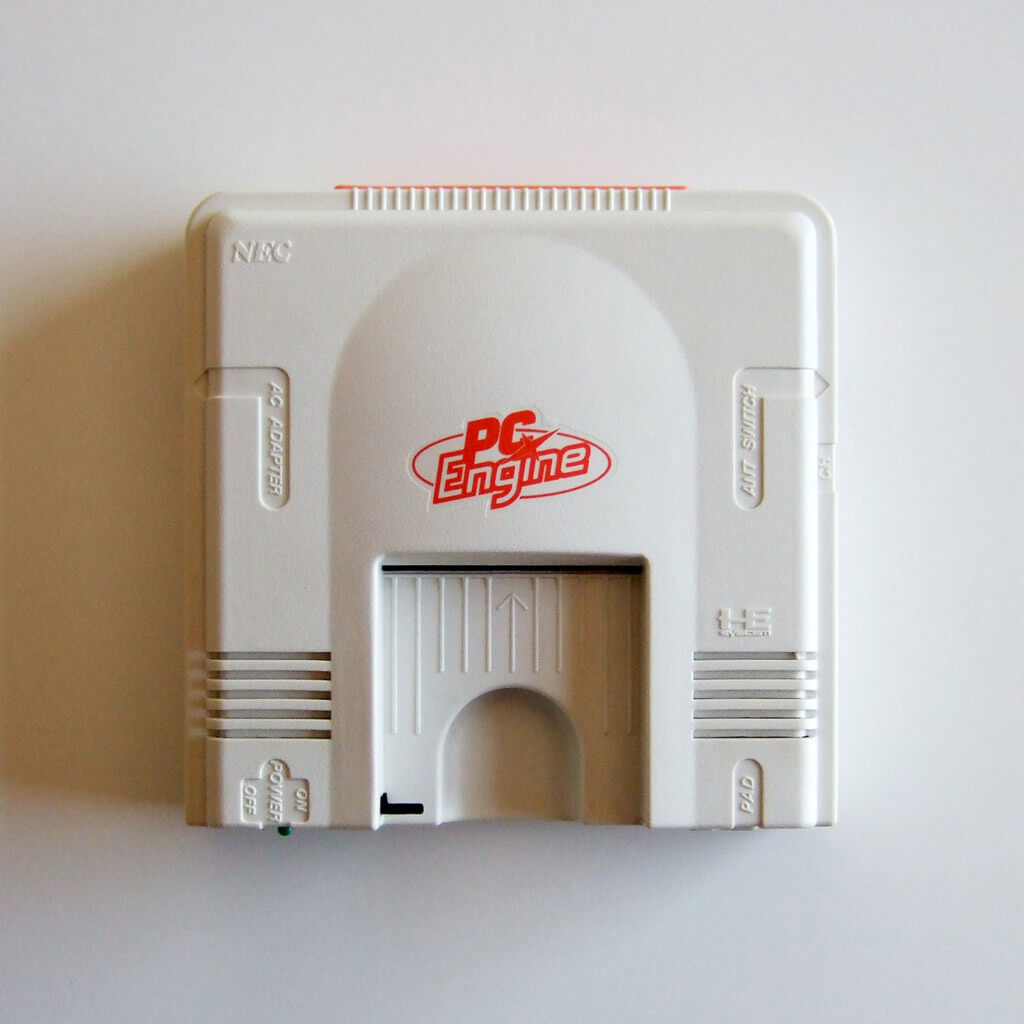
The philosophy of the PC Engine console was to have a basic “central engine”, a core which was the console to which peripherals were added, reaching the extreme of needing a multitap to play some doubles, since the console only had one input of a command. This concept was not at all misguided, since it lowered the cost of a console that was much higher than the Famicom, making it accessible to the bulk of the population, while being versatile enough to cover all player profiles by launching peripherals and new versions of the console itself as times and needs progressed (for new televisions for example), we are talking about 1987, a few years in which technological evolutions and changes followed one another relentlessly. To give you an idea, when the console was released, the original PC Engine had the following RF to TV adapter (very similar to the one on the Famicom):
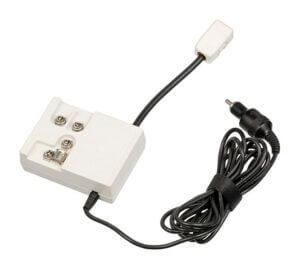
The PC Engine was a living console, in motion and continuously evolving, which unlike the conservative and static line of the Famicom and Nintendo. It evolved year after year with a wonderful premise, “Leave no one behind.” You bought the model you bought, NEC would launch the necessary peripherals to make the different systems and formats compatible, a success that its users knew how to value. In the history of consoles, there has never been a console that has made so much use of the expansion bus or has been revised so many times to adapt it to all customer profiles… Not even SEGA in its best times.

An example of what is mentioned in the previous paragraph is its 5 types of external memory to save the progress of the games as you see above (the console was inserted inside). Since it was impossible to save games on HuCards, which initially could not integrate a stack (1987), the only option that the developers had was to use passwords. Proven the weakness before the Famicom and its cartridges with the possibility of saving, different external memories were launched for the PC Engine that were mostly connected to the rear expansion bus. A perfect example of how different peripherals could be attached to a central unit according to the user’s needs.
PC Engine, the console that faced the biggest.
From this moment, I would like to make an appreciation: As we will see later, the PC Engine encompasses a set of consoles with the same base, the original PC Engine. Even so, as the years went by, the differences between the original model and its versions became more and more noticeable, so we must understand the PC Engine as a family made up of different peripherals and hardware updates, with the PC Engine being basic the central unit, which was always present and compatible. Only then will we understand how a NEC was able to face consoles like the SNES, Neo Geo or PSX and survive the attempt.
The PC Engine was released in Japan on October 30, 1987 for 24,800 yen and from its first day of release, it would be up against the best-known consoles of all time, quite an adventure for NEC’s first foray into the console market… Let the battle begin.
ROUND 1: PC Engine VS Famicom
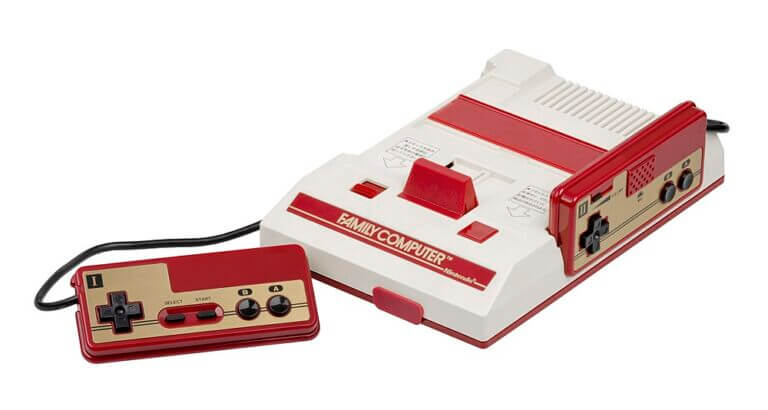
The guts of Hudson’s PC Engine might have been created to be compatible with a Famicom, but NEC’s PC Engine had been created to do away with the Famicom, it was their own Terminator. He got it? No, NEC’s console failed to overtake Nintendo’s Famicom, which had such deep market penetration that it was impossible to move it from the top spot in those years. Now, the PC Engine did quickly move into second place from which it would not move for many years.
Given the obvious technical superiority of the PC Engine, Nintendo pressured third parties to ensure the best conditions and exclusivities, they had a monopoly and could afford it. On the other hand, given the need to respond to graphic superiority, year after year they incorporated new support chips into their cartridges, this being their strategy in the face of NEC’s evolutions. The greatest exponent of these support chips would be the great Super Mario Bros 3, a beast that put the Famicom on a par with its most powerful competitors.
But the ’80s were a frenzy when it came to technological improvements, which we all witnessed in arcades. The Famicom was a 1983 console going up against a superior 1987 console, so it was clear that there would be a steady trickle of Famicom owners buying the new console wanting to experience 16-bit, which it did. But what did Nintendo do to prevent this? On November 21, 1987, exactly 22 days after the launch of the PC Engine, Nintendo presented to the Japanese press the prototype of its Super Famicom Computer, its next 16-bit console, showing the precursor of Pilotwings and its Mode 7 The release date they announced was July 1988…
The successor to the Famicom, a Super Famicom in just 8 months enlightened the minds of the Japanese… The bomb was gigantic and the impact on the PC Engine devastating, who was going to buy a new console knowing that in less than a year it would arrive the new Nintendo console? Fortunately, the Japanese market is very knowledgeable about video games and is governed largely by the quality of the same to buy one system or another, so the PC Engine achieved acceptable sales at this stage, but it is evident that the announcement Nintendo greatly limited its market. July 1988 came and nothing happened… July 1989? No, neither. The Snes would arrive at the end of 1990, that “eternal” wait gave NEC wings before those who were no longer willing to put up with further delays from Nintendo.
Still in a respectable second place against the Famicom, the PC Engine was positioned within the public’s mental framework, as a clearly superior console to the Famicom, something decisive to increase its sales little by little, whether they were former owners of the Famicom or new users who bought their first console. The PC Engine was gaining ground against the 8 bits of Nintendo and to mark even more distances, it launched its first CD ROM 2 for its consoles, the future was called PC Engine.
Round 2: PC Engine VS Super Famicom, Mega Drive and Neo Geo
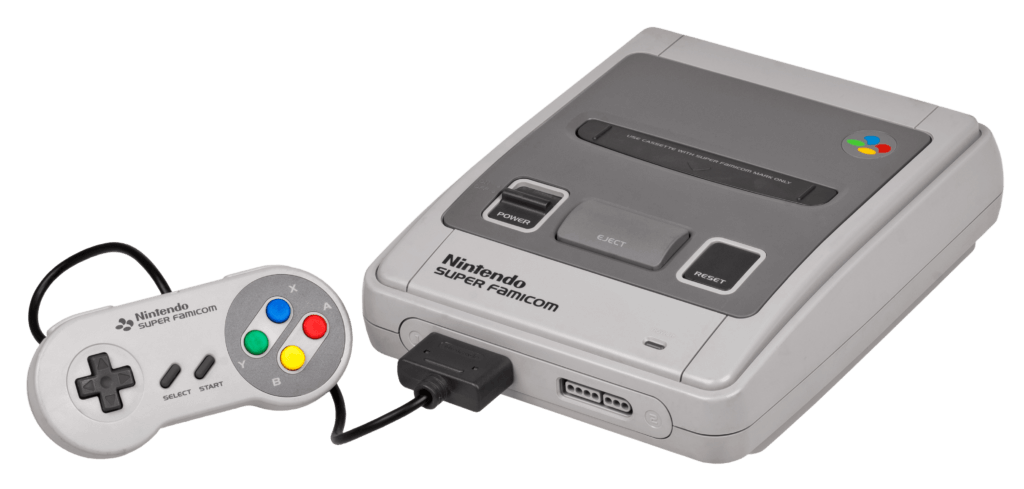
And the next battle came for our beloved PC Engine. If with the Famicom the problem was its high market penetration, with the arrival of the new consoles and the start of the 16-bit war, NEC would face new opponents that, unlike its previous stage, were theoretically superior in performance techniques, quite a challenge for the small PC Engine… Although it would not be alone.
The first to arrive was the Sega Mega Drive, just 1 year after the release of the PC Engine. The 16-bit war began with two consoles whose main objective was to beat an 8-bit console, curious. SEGA was a company of recognized prestige in Japan, of Japanese-American origin, it had been in the market for electromagnetic arcades, recreational games and home systems for decades. Many of the best arcade video games of the time were theirs and that is what SEGA wanted to bring to Japanese homes, a console capable of carrying the video games of its System 16 arcade board, being an adaptation of it. A whole machine.
But despite being a great console, SEGA and its 16-bit consoles did little within their own borders. The reason? A Nintendo masterstroke, in the purest style of the German blitzkrieg of the Second World War, Nintendo did not allow SEGA to rear its head, giving it the coup de grâce on its first day: If SEGA launched its Mega Drive on October 29, 1988 , Nintendo released its Super Mario Bros 3 (with built-in support chips) on October 23, 1988, a week earlier. Nintendo taught the world that the most anticipated game of all time at that time was capable of competing graphically with 16 bits, becoming a must buy for the huge market of Famicom owners. Demolishing for the Mega Drive.
After the initial defeat by SEGA and the impact of SMB 3, the PC Engine was at all times ahead of SEGA within Japan, the software offered by PC Engine was much more localized and focused on the Japanese market, being on the other part the price of its cheapest games thanks to the lower price of the HuCard compared to the cartridges. PC Engine won this battle and was ahead of SEGA at all times of the 16 bits in Japanese territory, not bad for the NEC console.
Once surpassed the 16-bit SEGA, NEC knew that the rival to beat would be the Super Nintendo. The PC Engine was subtracting users from the Famicom and increasing its presence in the console market in Japan, Nintendo was not going to allow this situation to continue for a long time. Fortunately for NEC, Nintendo delayed the release of the Super Famicom numerous times, giving the PC Engine a few years to take over the 16-bit market, until the day came… November 21, 1990, the Super Famicom was released throughout Japan. The PC Engine would see them again with the almighty Nintendo and its new 16-bit machine.
The launch of the Super Famicom was a success, in a few hours the 300,000 units served were sold and due to the altercations and long queues of young people waiting to buy the successor of the Famicom without going to class, the Japanese government asked the manufacturers of videogames that from now on made their releases on weekends. Nintendo’s new console quickly positioned itself at the top of the sales ranking, quickly surpassing the PC Engine. Even so, NEC was not going to make it so easy for Nintendo, and just a year after the launch of the SNES, it would launch two products that would put Nintendo’s supposed technological superiority in serious trouble: The PC Engine Duo (Turbo Duo in west), a console that integrated the new NEC CD-ROM player, being an extremely interesting system for users who did not have a PC Engine and wanted to make the leap to the CD ROM format, and secondly the SUPER CD- ROM 2 released in late 1991, a new peripheral that improved on the first version of CD ROM 2.
Both the new console and the peripheral used the new SUPER CD-ROM 2 format, providing gamers with better video games, far superior to the Super Famicom in many ways thanks mainly to its large storage capacity. These possibilities were greatly appreciated by the developers, who were quick to support the new NEC format, unlike the first CD-ROM 2 which had lesser reception.
Could these technological innovations with the Super Famicom? No, they made fans of the PC Engine very happy, taking a 1987 console to unimaginable places, but the Super Famicom remained number 1 thanks to the exclusivities and beneficial conditions it still had with top developers like Capcom, Konami, Tecmo, Square, Koei or Enix, in addition to their own Nintendo brand video games. On the other hand, the Nintendo console, although not cheap, was much cheaper than any of the combinations of NEC and its CD-ROM 2, something extremely important. In front of the SUPER CD-ROM 2, Nintendo threw good smoke to calm its users by announcing a SNES CD that never arrived.
In this way, the Super Nintendo remained the leader in the sector at all times, with a PCE in second place that maintained a differentiated quality catalog and increasingly focused on SUPER CD-ROM 2. It may not seem like a victory, but keeping a 1987 console alive in the face of a technical, media and commercial beast such as the SNES, is quite an achievement that many companies of the time failed to achieve.
But if the Super Famicom was not enough, the PC Engine would have to deal with another much more powerful opponent, a black beast, the Roll Roice of consoles and possibly the most desired retro video game console today: The Neo Geo AES from SNK.
The Neo Geo AES was a NEO GEO MVS (the arcade) encapsulated in a home console. Launched on April 26, 1990 in Japan, initially its business model was to rent the machine along with its video games, understanding that no one would be willing to pay what the machine and its games cost… But there were people willing, and much more than they initially thought, luxury was established in the video game console market and offered us unimaginable features, the Neo Geo was an arcade at home with large storage capacity cartridges comparable and even superior to what it offered a CD ROM, thus avoiding annoying loading times (wallet-based).
And what did NEC do before this super console? Nothing new, NEC had already released its super console a year earlier, the Super Grafx, a console comparable in performance to the Neo Geo, but due to its high price it sold very few units, a fact that led to only 5 video games being released specific for the console, so in practice, even having a super system, the Super Grafx and the Neo Geo did not really face each other on the battlefield.
As with the rest of the 16-bit consoles, the PC Engine was hardly affected by SNK’s Nego Geo, a console that from the beginning was acquired by a very specific wealthy public, able to pay the high price of its software. Neo Geo played in another league and was not competition for the PC Engine, both consoles coexisting perfectly for many years, as well as their different versions. But what happened with the arrival of 32 bits? Did the PC Engine withstand the onslaught of a third generation of consoles?
Round 3: PC Engine VS Saturn and PSX

At the end of 1994 SEGA and SONY released their new 32-bit consoles. After many unsuccessful attempts, the fifth generation of video game consoles settled down with two of its greatest representatives, the Saturn and the PlayStation, two consoles with optical formats that bet on the new polygonal graphics as the future of video games… And they were totally right . Would this generation kill the PC Engine? No, not yet…
Starting in 1994, PCE and its developers focused almost exclusively on the SUPER CD-ROM 2 format, thus minimizing the technical differences in the face of new competition and maintaining a good number of releases during the years 1994, 1995 and 1996, with 1999 being the year in which their last commercial video game was published: Dead of the Brain 1 & 2. The SUPER CD-ROM 2 format offered, on the other hand, the possibility of making notable video games of certain genres such as RPG or decision-making with animations (genre bishōjo or dating for example), something that contributed to further extend the life of the PC Engine and its variants.
In this way, the family, the PC Engine universe created in 1987, had a more than intense commercial life until 1996, being one of the most beloved and missed systems in Japan, coming to coexist and surpass in commercial life what would be its successor, the PC FX, the 32-bit from NEC that launched its last commercial video game in 1998. But as we have already seen, PC Engine is much more than a console, let’s get to know its main peripherals and versions
The PC Engine CD-ROM 2 and SUPER CD-ROM 2
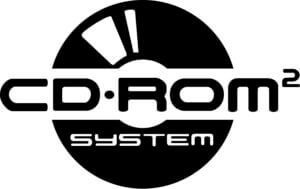
As we have already discussed, NEC’s initial idea was to use its CD-ROM players to further increase the technical difference with Nintendo’s Famicom. It should be remembered that we are talking about a console designed in 1985 and launched in 1987, so even though NEC’s intentions are surprising, it is to be thanked for the pockets of the populace who, in the end, faithful to their philosophy of the “central unit” , adopt HuCards as a format and leave the CD-ROM for later…
If the PC Engine was launched in Japan in October 1987, the Japanese hardly had to wait a year to enjoy one of the peripherals most anticipated by all video game lovers of the time, the CD-ROM, in this case of the PC Engine as is evident. The technological leap that it meant for the time was abysmal, known as CD-ROM 2, it made it possible for developers to include music, voices, animations and hundreds of megabytes of data to elevate the PC Engine to the Olympus of video games, placing it in many genres by on top of the arcade machines of its time thanks to its format.
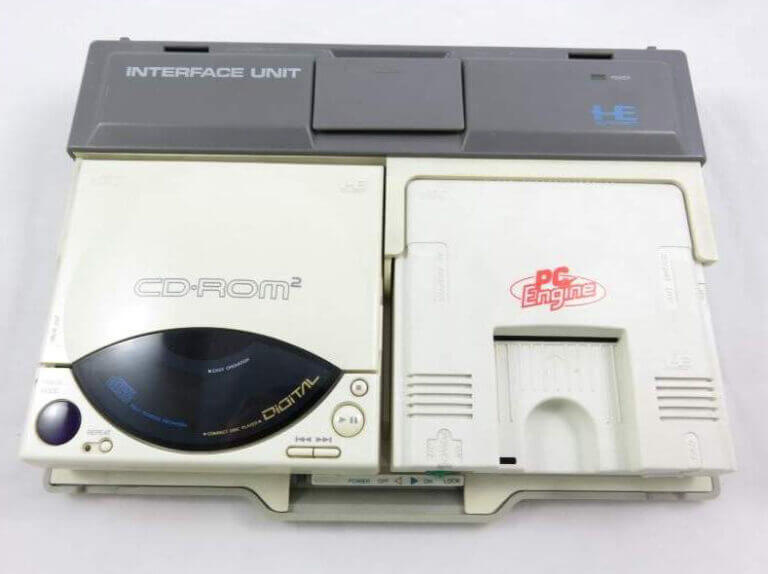
In this way, on December 4, 1988, just for the Christmas campaign, NEC launches CD-ROM 2 together with the interface to connect it to the console and its Bios on a card (the System Card), becoming the PC Engine in the first console in history to have the CD-ROM as a video game format. This gem of retro video games was a real revolution at the time, reaching a monstrous storage figure of 540 MB, a real madness for the time. His first video games were Fighting Street, which is none other than the first conversion to a home console of the first Street Fighter and No Ri Ri Ko, a game too Japanese for us (I mean it).
Initially, CD-ROM 2 did not enjoy great prestige, the reasons were the lack of memory on the one hand (64 KB of SRAM and 64 KB of DRAM for ADPCM), which made the loading times constant and too long. extensive, a real problem for the pace of video games compared to cartridges and HuCards (as would happen to SNK years later), and on the other hand the price of the system: Being the first CD device for consoles, the player was considered by the Japanese government an audio device, being subject to special taxes (something that would change shortly). The CD drive was 32,800 yen and the interface (excluding excise) 27,000 yen, about 530 euros in total (2020), which in 1988 was roughly the equivalent of 1,300 euros today (2020)… As you can imagine, a number of money that very few were capable of assuming. Later, games like Tengaimakyo ZIRIA, Ys I – II and Super Darius would come out, which, focused on taking advantage of the benefits of the new format, would demonstrate the superiority of the system and would manage to create a base of players who were willing to invest a large amount of money to have the best video games of the moment (blessed Japan). Even so, being the first of the CD ROM systems for consoles, reliability and stability were poor, something that also worked against it for the general public.
For those of you who have been surprised by the costs of CD ROM 2, let us remember that in those years Japan was going like a shot in its economy, since the 70’s its currency had had a strong appreciation, due to moving from an economic model that it changed primary and secondary activities such as agriculture, mining and manufacturing, for information sciences, telecommunications and technology. One of the consequences of this economic boom within Japanese society and companies is that workers received a notable increase in their benefits, having a great purchasing power compared to other countries. Added to a larger adult video game fan audience compared to the West, this situation made it possible for there to be a market for the business model of the PC Engine and its variants.
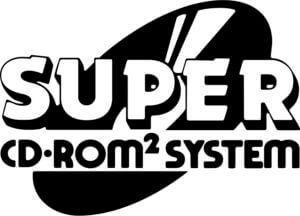
Commenting on the previous point, let’s go back to the PC Engine and its CD-ROMS, because yes, like the SEGA Mega Drive, the PC Engine also had 2 CD ROM players. As we have already mentioned, the high price and the lack of memory were the main factors that played against CD ROM 2, something that caused that even marking the way forward for the industry, it did not have a great impact and its catalog was reduced. . But at NEC they were convinced that the CD-ROM was the optimal format for video games, so on December 13, 1991 they launched the SUPER CD-ROM 2, a peripheral that corrected the failures of its predecessor and which had much more success and a much broader catalog, being able to run the games in SUPER CD-ROM 2 format without the need for any expansion card.
Curiosity! NEC did not endow CD ROM 2 with any anti-copy security measures, and it is also region free. The reason? Simple, in those years there were no home CD ROM recording equipment.
SUPER CD-ROM 2 had an MSRP of 47,800 yen instead of nearly 60,000 yen, while incorporating 256 KB SRAM and 64 KB DRAM for ADPCM, it was also reliable and stable. Thanks to the benefits of the system, sales skyrocketed, reaching more than 2 million units sold between both players, the vast majority in Japan. SUPER CD-ROM 2 exploited the system and went on to have one of the best quality/period catalogs ever created. Far from being a commercial fiasco abandoned after a few years, as happened with other systems (Mega CD, Atari Jaguar…), it extended and nourished NEC’s consoles until 1999 (Dreamcast times), when its last commercial game, Dead of the Brain 1 & 2.
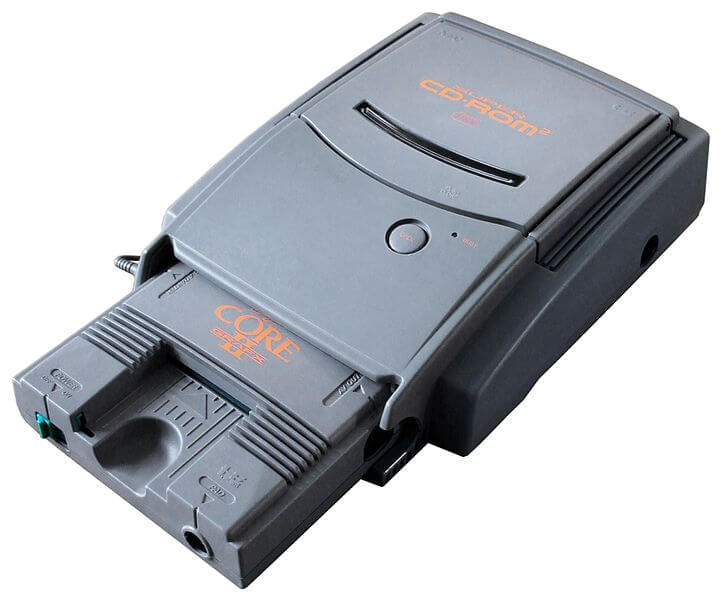
And the compatibilities? The first CD-ROM 2 is compatible with PC-Engine, Coregrafx, Coregrafx II, PC Engine LT and Supergrafx through the latter’s adapter. For its part, the SUPER CD-ROM 2 is compatible with PC-Engine, Coregrafx, Coregrafx II, PC Engine LT with adapter and Supergrafx. What if we already had the first CD-ROM 2? Are SUPER CD ROM 2 games compatible with the first CD ROM 2? Don’t worry and yes, they are compatible by acquiring the Super System Card 3.0, which compared our old CD-ROM 2 in memory to the new one and transported it to the future of video games.
Thanks to CD-ROM 2 and SUPER CD-ROM 2, developers were able to create new genres focused on the capabilities of optical formats, in addition to making technically speaking better games by having hardware superior to that of the original machine, with the possibility of include digitized voices, music, animations and scenes. In this way, the PC Engine had a magnificent catalog of graphic novels, decision-making video games, interactive anime and immense RPGs, a specialization that undoubtedly contributed to lengthening the life of the system.
All PC Engine console models
Without a doubt, the PC Engine is characterized by the large number of models and different versions of the console, all these systems having a common denominator: compatibility with the central unit, the original console. Thanks to this philosophy, users were able to enjoy a system that lasted many years, being renewed for new buyers without forgetting/abandoning those who had already purchased a previous system. Let’s meet the great family of PC Engine video game consoles:
PC Engine / Modelo PI-TG001
Japan and France
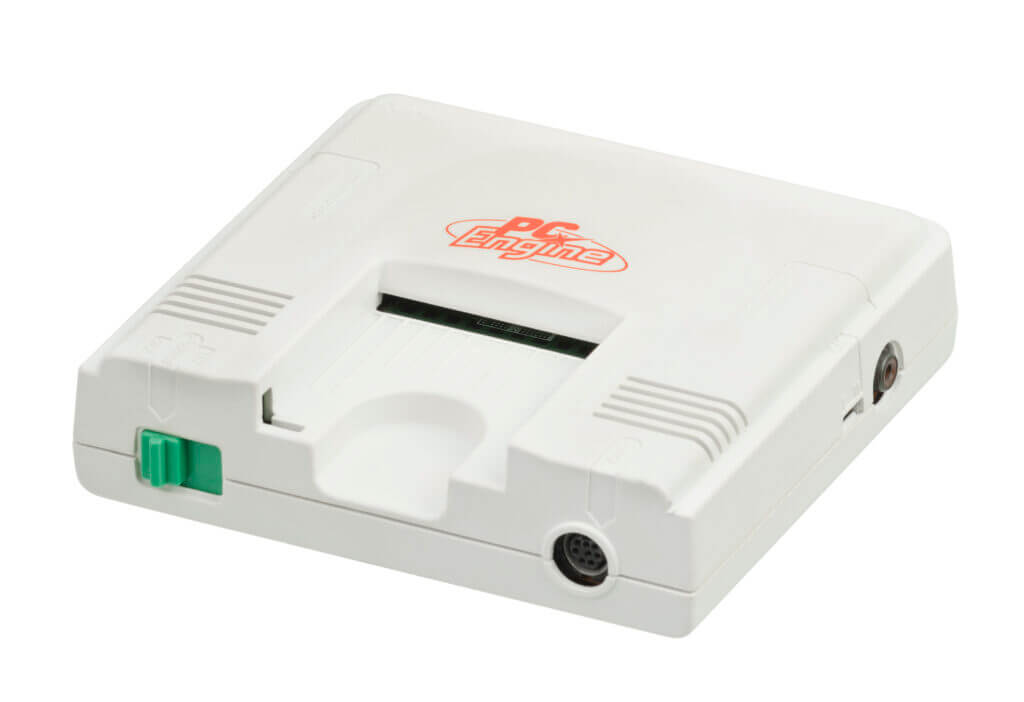
The original PC Engine, the protagonist of this article, the core, the central engine from which an entire universe of consoles and video games was created. The first model was sold in Japan and France (with scart), it was launched on October 30, 1987 in Japan for a price of 24,800 yen, becoming the rival of the Famicom in Japan.
SHARP X1 Twin / Model CZ-830C-BK
Japón
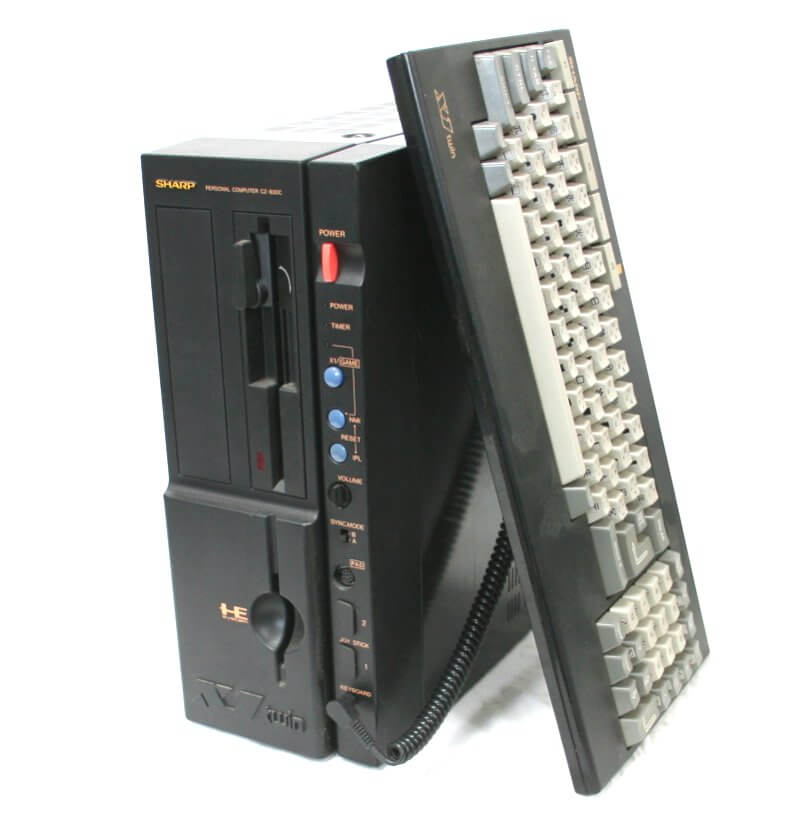
In December 1987, SHARP released a version of its X1 line of computers with a little surprise inside, nothing more and nothing less than a fresh-from-the-oven PC Engine built into its guts. SHARP, which years later would continue to surprise us with combined systems, presented us with this hybrid system that in practice resulted in two independent systems that shared video output and power supply. Its price? 99,800 yen.
NEC modelo PC-KD863G
Japan
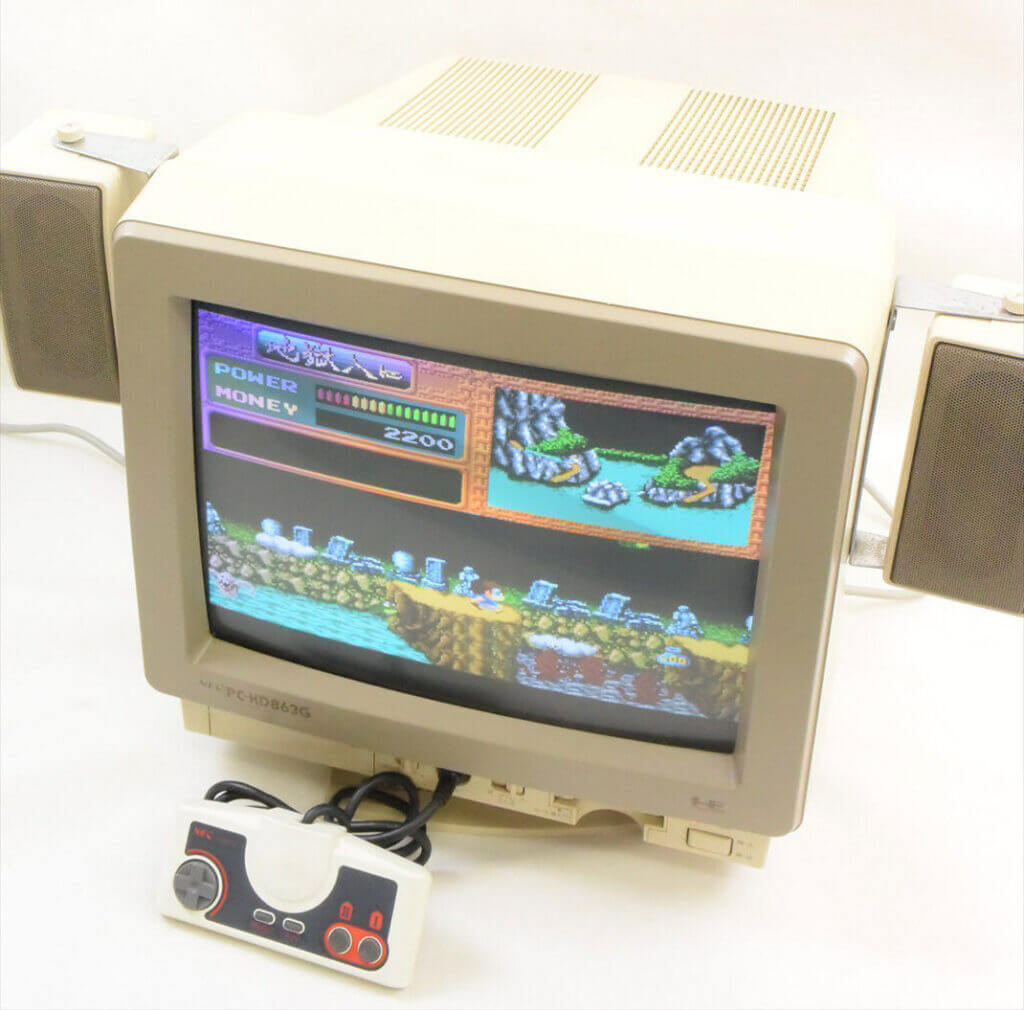
Launched on September 27, 1988, NEC integrated a PC Engine into a monitor, something that may seem ridiculous now but that made sense in those years for 2 reasons: In homes there was normally only one television and, being RGB and with the consequent increase in quality, it is said that specialized media could use it to take screenshots. Its price was 138,000 yen and it remains an anecdote within the PC Engine universe as it does not have an expansion bus for future expansions.
TurboGrafx 16
EEUU y Europe
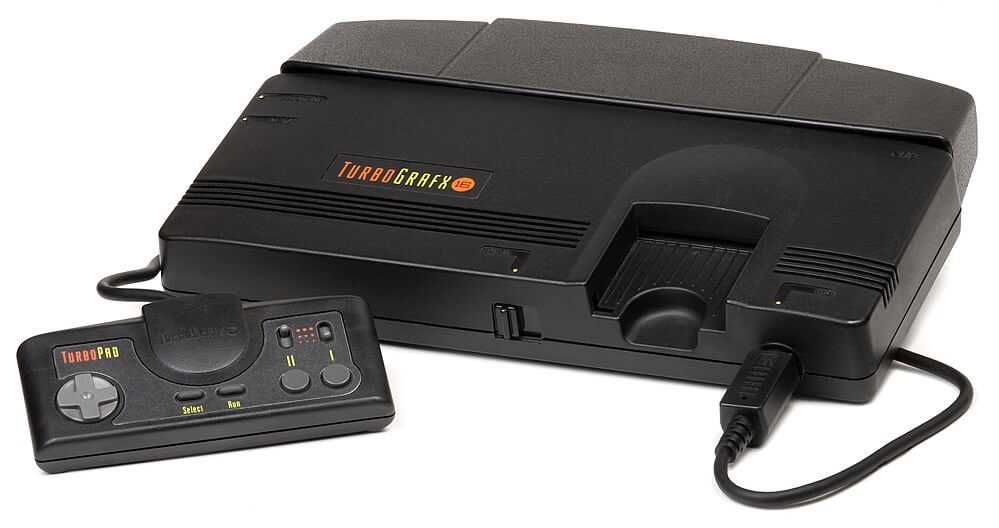
On August 29, 1989 in the United States and on November 22 of the same year in Europe, the western version of the PC Engine arrived: TurboGrafx 16, with special emphasis on its 16 bits. This console is none other than the PC Engine with a change of casing to suit the Americans, who theoretically like large consoles (according to the Japanese), with the corresponding modifications for European and American televisions. Unlike in Japan, the TurboGrafx 16 had little success, falling far behind Nintendo and SEGA, especially at the height of the 16-bit era. The fact of not being region free with its HuCards meant that it had a very limited catalog compared to its Japanese version, barely surviving until 1994 despite having peripherals such as the CD ROM.
PC-Engine Shuttle / Modelo PI-TG2
Japan
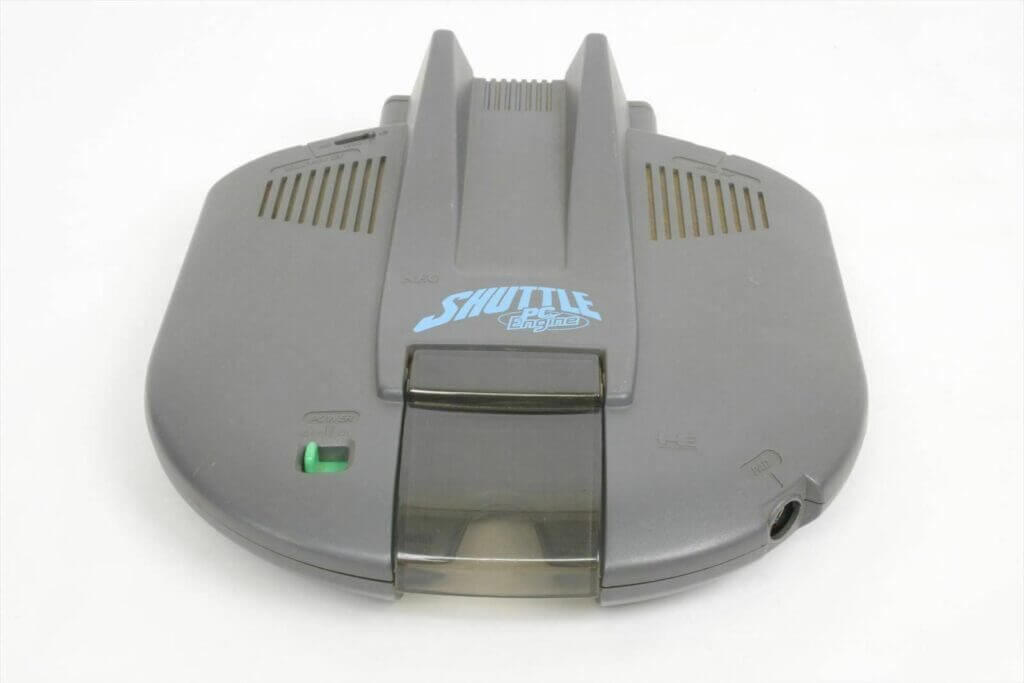
This PC Engine better known as the Shuttle Grafx, was a cheaper version of the original PC Engine that eliminated the expansion bus, something that on the date of its launch on November 22, 1989 could make sense, but as it was shown a short time later, they make it the worst option when it comes to purchasing a PC Engine as they cannot have the catalog released on SUPER CD ROM 2. Its recommended launch price was 18,800 yen. And yes, it is shaped like a spaceship.
PC Engine Core Grafx / Modelo PI-TG3
Japan and France

Released on December 8, 1989, the PC Engine was updated with minor changes thanks to its new model, the CoreGrafx. With this model that replaced the RF signal cable with a composite video cable, thus adapting to the new televisions that reached most Japanese homes. A very interesting and recommended model for collectors that came out with a recommended price of 24,800 yen.
PC Engine Super Grafx / Modelo PI-TG4
Japan and France
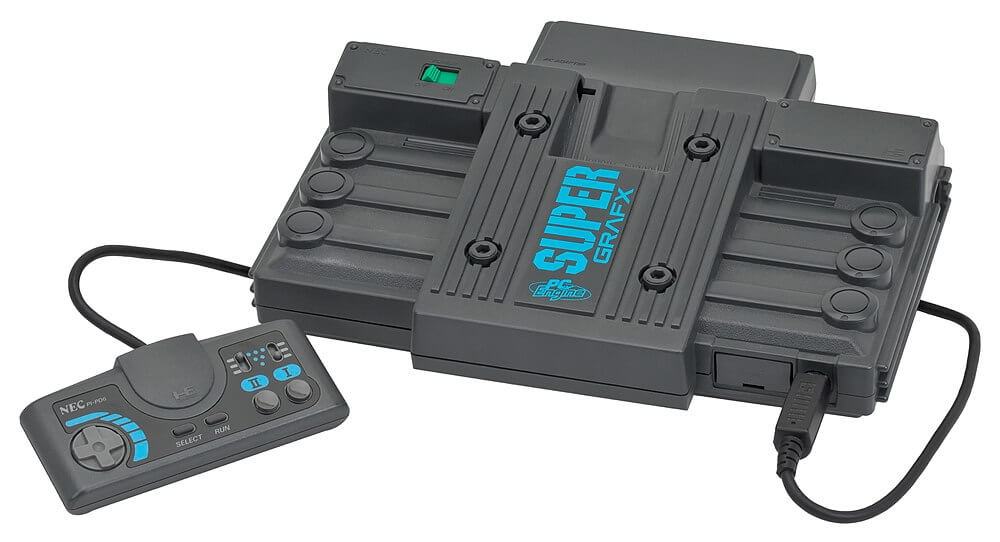
The PC Engine Super Grafx was released on December 8, 1989 for an NEC suggested retail price of 39,800 yen. The one that had to be the successor of the PC Engine, became a deluxe version that doubled the graphic capacity of the original, being able to port the arcade video games of the moment with pixel perfect conversions. Still an enviable machine and comparable to the Neo Geo, only 5 exclusive games were released for this system, which precipitated the system’s crash but fortunately for its owners, it was fully compatible with the games and peripherals of the original system. Today it is one of the most sought after jewels by collectors of retro video game consoles.
PC Engine GT / Turbo Express / Modelo PI-TG6
Japan, EEUU y Europe
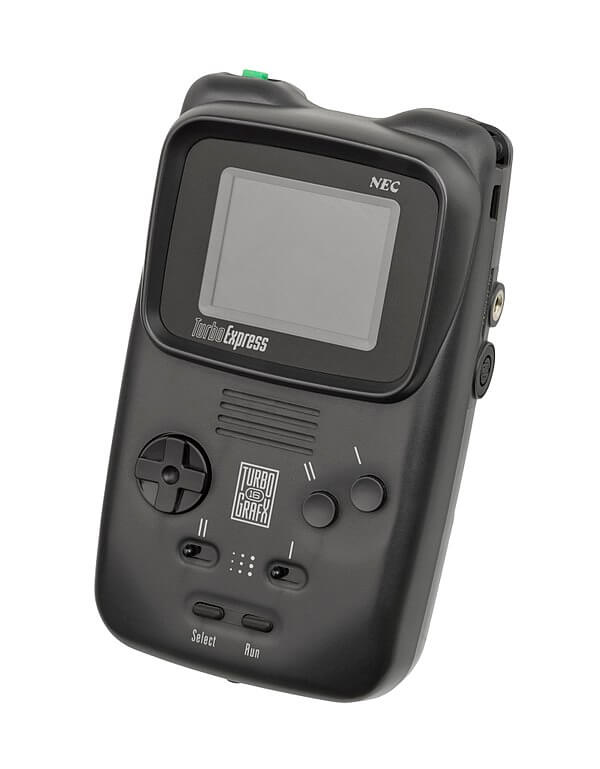
This retro beauty was launched on December 1, 1990, being the first 16-bit portable console in history, an advance for the time, far superior to the Game Boy and its 4 shades. The concept was very simple, having a PC Engine or Turbo Grafx in your hands, that easy, that perfect. The name of PC Engine GT comes from “Games and TV” (Turbo Express in the USA), since the console could become a television with the corresponding peripheral (as would the Game Gear). Its launch price was 44,800 yen, a real outrage that still managed to sell more than 1 million units worldwide, the idea of being able to play your PC Engine games anywhere was very tempting for the wealthy of the moment.
PC Engine Core Grafx II / Modelo PI-TG7
Japan
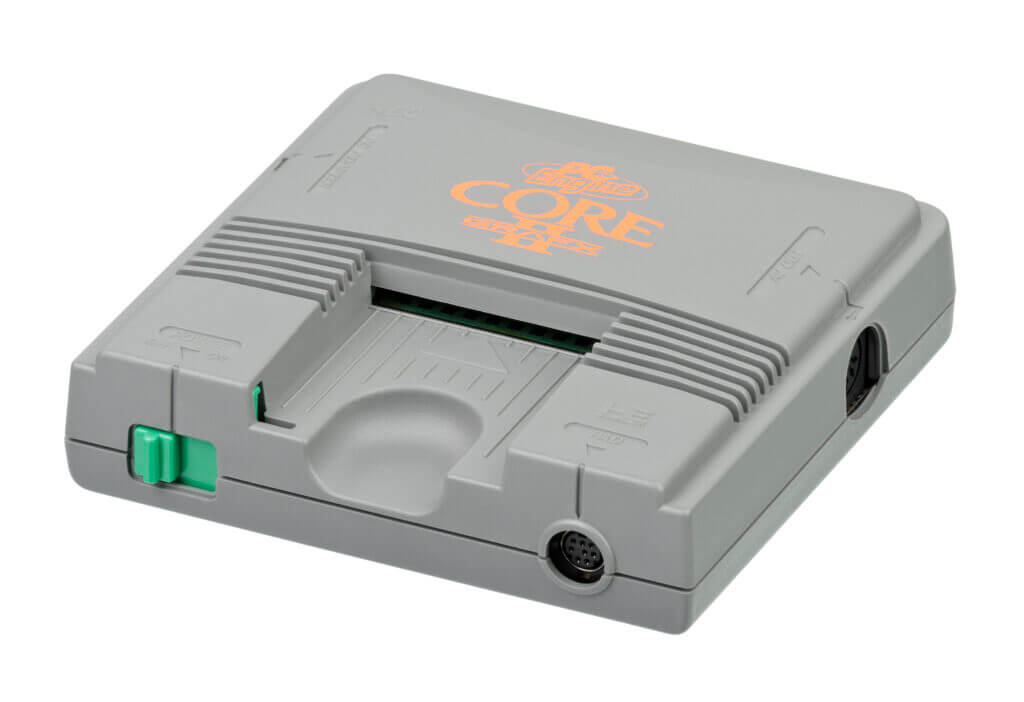
The CoreGrafx II is a revision released on June 21, 1991 with minor changes compared to the previous Core Grafx, whose differences at first glance were visual, changing the color of the casing and logos, thus following the same aesthetic as months later I would have the SUPER CD ROM 2 (December 91′). The recommended price this time was 19,800 yen, a very attractive price to purchase the combo.
PC Engine Duo / Turbo Duo / Modelo PI-TG8
Japan, EEUU y Europe
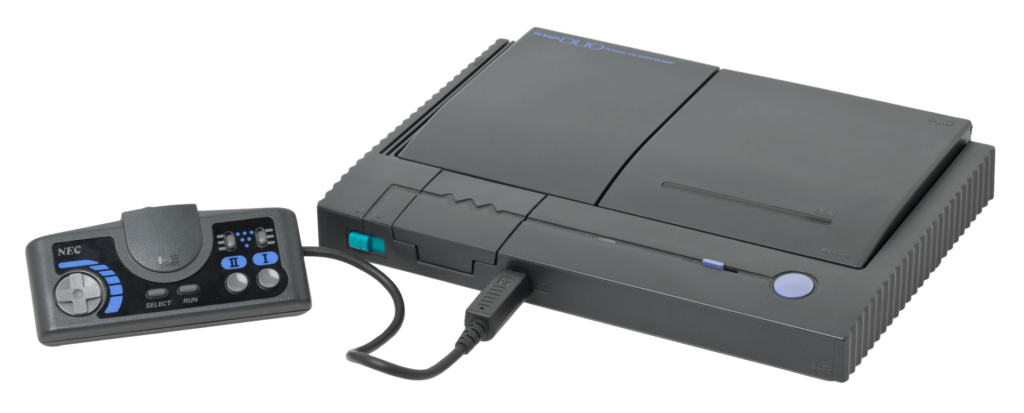
On September 21, 1991, NEC launched this wonder with a recommended price of 59,800 yen. A beauty that combined in a single console the PC Engine with its SUPER CD ROM 2, plus an integrated battery to save our games without the need for peripherals. In this case, the expansion bus was not necessary since it had everything, so it was removed. This console is one of the most versatile of the PC Engine family since it can practically play all the formats by itself (not all). In the US and European markets the console was called the Turbo Duo, being the only one of the 3 models to come out of Japan.
PC Engine LT / Modelo PI-TG9
Japan

The PC Engine LT, whose name comes from the term Laptop, is one of the most sought after consoles by collectors, and it is not surprising: On December 13, 1991, NEC launched one of the most exclusive versions of its PC Engine, designed for the small homes of the big Japanese cities, a country from which he never left. The PC Engine LT is a portable console, which is not portable since it does not have its own battery, the console included a control in the casing itself and what is more evident and attractive, a 4-inch TFT LCD screen with its speakers and tuner. TV. Also, the console was compatible with peripherals such as CD ROM. Its price? 99,800 yen, an outrage for the time, but it was the cost of being trendy in the land of the rising sun.
PC Engine Duo R / PI-TG10
Japan
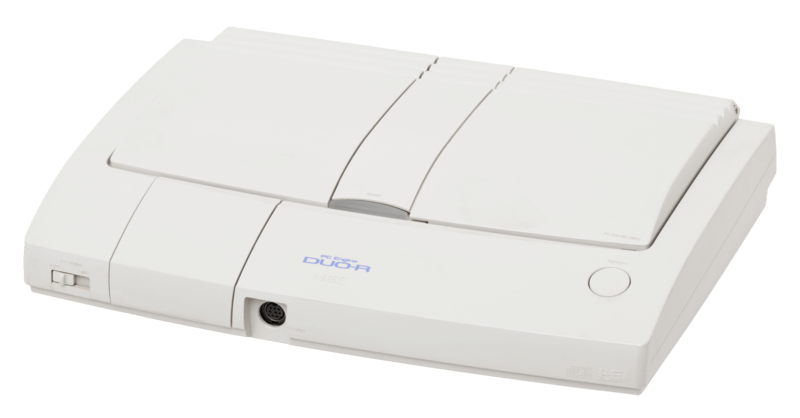
Launched the PC Engine DUO-R on March 25, 1993, this is the economic version of the PC Engine Turbo Duo, since the headphone jack and battery input were removed to make it “portable”. Not released outside of Japan, this beauty sold for 39,800 yen and is a great option for those of you thinking of starting to collect the system. Regarding the “R”, it comes from “round”, rounded in English, due to an aesthetic difference compared to its angular predecessor.
Pioneer LaserActive / Módelo CLD-A100
Japan, EEUU y Europe
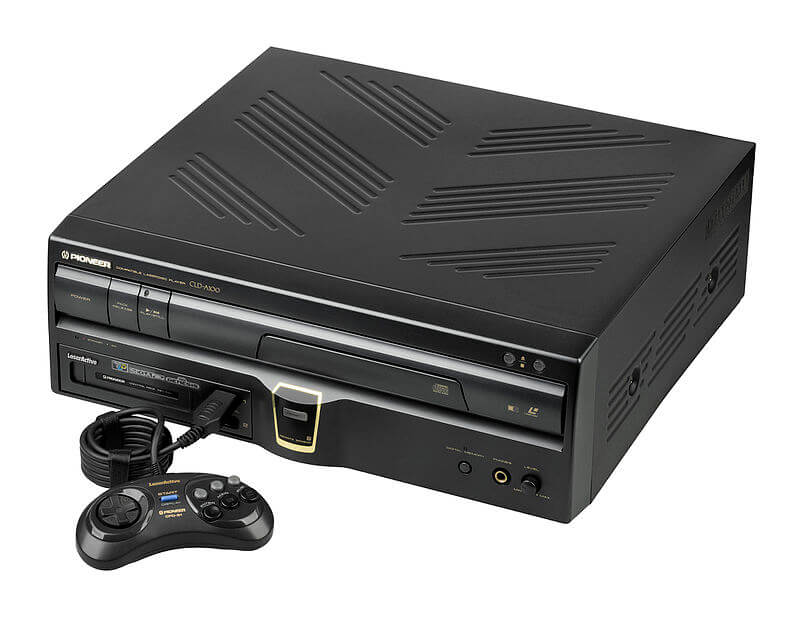
Launched on August 20, 1993 by Pioneer, this multimedia player whose main format was LaserDisc (in addition to CD), went on sale for 89,800 yen with the possibility of integrating two modules inside (in 1 slot), the the MegaDrive from SEGA or the PC Engine from NEC. Both modules had a cost of 39,000 yen and made it possible to play their video games both in cartridge and HuCard format as well as in optical format, existing video games for the console in their exclusive format, LD-ROM 2 and MEGA-LD, which made use of the LaserDisc offering greater benefits. As you can imagine, despite the numerous multimedia uses offered by the machine, Pioneer’s adventure ended with the arrival of 32-bit consoles from SEGA and SONY. The Pioneer LaserActive is one of the most sought after and valued retro consoles today.
NEC LaserActive / Modelo PCE-LD1
Japan
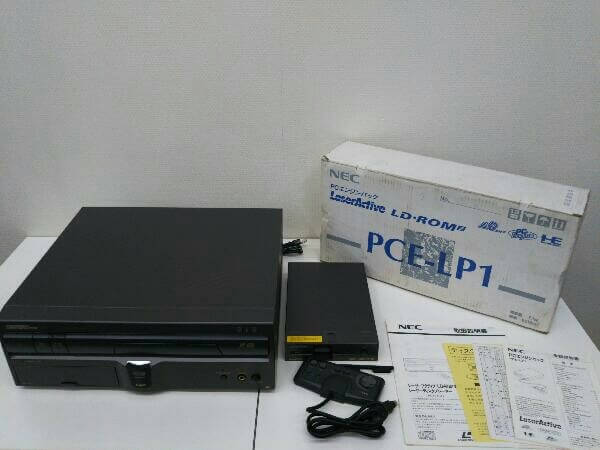
At the beginning of the 90s, the term multimedia was fashionable, being a trend that many video game manufacturers assumed as the way forward, the market was filled with new products with little commercial success. Pioneer, a company that was a staunch defender of Laserdiscs, had already launched its LaserActive a few months earlier, with the possibility of including a PC Engine module inside. As a result of the previous agreements, NEC would launch on December 1, 1993 its own version of LaserActive in addition to the PC Engine module, thus adding a new format to the family, the LD ROM 2, which was needed. The price of the player was 89,800 yen to which 39,000 yen had to be added for the PC Engine module. A madness that together with Pioneer’s LaserActive sold less than 120,000 units worldwide.
PC Engine Duo RX / Módelo PCE-DUORX
Japan
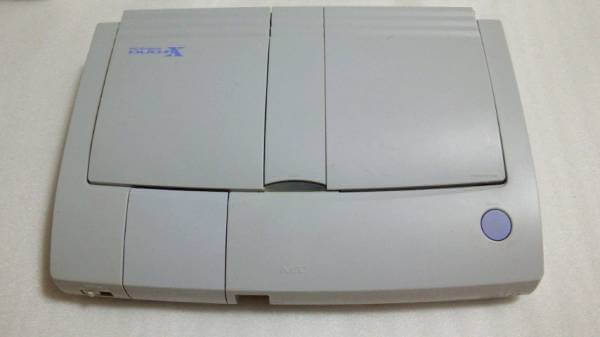
Released on June 25, 1994 for 29,800 yen, the PC Engine Duo RX is a cheaper version with minor changes from the Duo R. In practice, a 6-button pad is incorporated and the CD-ROM is improved, making it faster the reading. This model never left Japan and responds to a way to cheapen the best PC Engine hardware to deal with the 32 bits that were to come. For collectors, it is a great option to enjoy most of the PC Engine catalog.
Korean PC Engine
Korea
As if the life of the PC Engine had not been busy enough, I will try to make a brief summary of what happened with the NEC console in neighboring South Korea, a country where Japanese companies have traditionally distributed their consoles through Korean companies such as Hyundai ( Nintendo), Samsung (SEGA) or Daewoo (MSX), going from systems like the MSX to 16-bit consoles.
In the case of the PC Engine, South Korea was able to enjoy the original version imported by a company called Alpha Trading, with various peripherals such as the CD ROM 2 itself and promoting a combined console and CD ROM 2 price of 450,000 won, an exorbitant price for the time higher than the average salary of a Bank of Korea worker. Even though it was a machine far superior to the existing ones, its main competitor was the Nintendo NES, launched in South Korea by Hyundai Electronics under the name of Hyundai Comboy, which was succeeding, as well as all the Famicom clones that were in those days. years. The result was that the importation of the product was not successful, being relegated to being the console of a very wealthy minority.

Have the Koreans resigned themselves to not having the PC Engine on their borders? Not at all, after the failure of importing the original product and promoting it alongside CD ROM 2, Daewoo Electronics thought it could do better and shipped the PC-Engine Shuttle, the cheap version of the PC Engine which lacked an expansion bus for the CD ROM. Actually the move was not so badly thought out, the PC-Engine Shuttle was a console in itself much superior to the Famicom and Daewoo was confident that by launching a PC Engine at an affordable price, players would opt for the most popular video game console. powerful… And besides, the console was shaped like a spaceship like their previous MSX-based consoles, the Zemmix… It all added up.
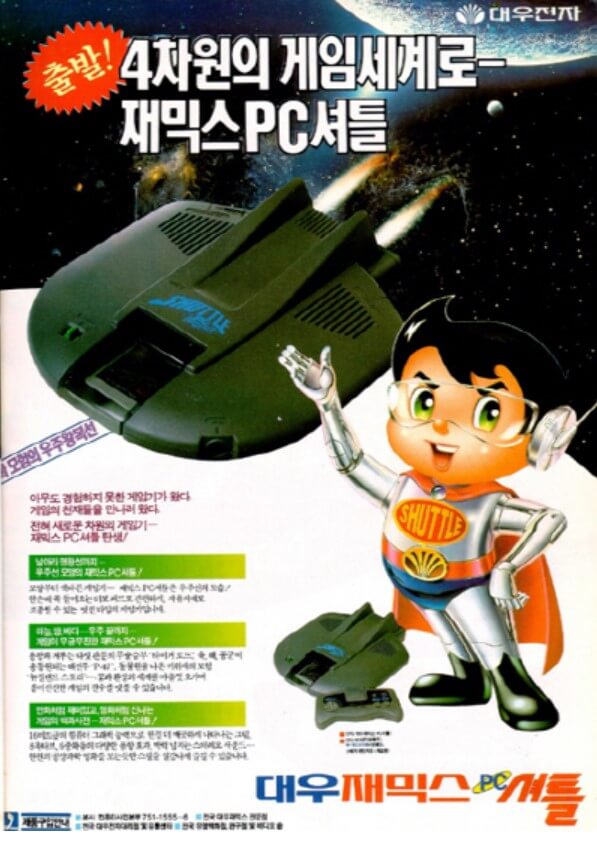
The PC-Engine Shuttle held its own against the 8-bit imports from Nintendo and Sega, the Hyundai Comboy (NES) and the Samsung Gameboy (Sega Master System), but the 16-bit Nintendo and Sega arrived and the Daewoo console couldn’t do nothing against a 16-bit marketing, its 8-bit CPU being unfairly a burden that prevented it from fighting on equal terms.
And this is where we should end the story of the Korean PC Engine consoles, but no… After the failure of the Shuttle, another Korean company thought that it could do better, that the mistake was to have a console shaped like a spaceship and that it had to be emphasize at all times the 16 bits of graphic power to face the Nintendo and Sega consoles, just as it was done in the North American market. Thus, in a polarized 16-bit market and in the midst of a war between Nintendo and SEGA / Hyundai and Samsung (this already looks like Naruto), the Korean company Haitai launched the motherboard of a North American TurboGrafx 16 with a new casing and mascot, in addition of an adapter to be able to play Japanese games, the «Vistar 16«. Wonderful.

Haitai’s effort to launch a supposed new 16-bit console, which coincided with the PC Engine Shuttle itself, which was despised by the public for having an 8-bit CPU, was clearly disastrous. But Haitai learned something, at that time (early 90′) the strong point of the PC Engine was not its core or basic console, but everything it could do in combination with its SUPER CD ROM 2. Haitai started working on a console that offered the desired combo, but a ray of light and sanity must have hit the offices of the Korean company, since analyzing the market they realized that the fight between Nintendo and Sega was so strong that there was no longer room for a new opponent, users had already positioned themselves as fanboys for one or the other. This caused them to reject launching new Korean versions of the PC Engine.
ARCADE CARD PRO and ARCADE CARD DUO
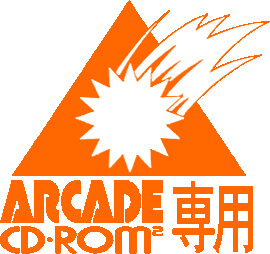
In addition to the two CD ROM players and all the console versions released, the PC Engine featured from the spring of 1994 a new video game format that further increased the quality of the SUPER CD ROM 2 games, this new format was called ARCADE CD ROM 2, in clear reference to equating the machine to the recreational arcades of the time or superior consoles from the competition such as the Neo Geo.
In order to enjoy this new format, the pinnacle of the PC Engine universe, they launched two cards of a different HuCard model that included 18 Mbit of RAM and were inserted in the same slot, obviously it was necessary for the PC Engine to have a CD ROM player 2. 12 titles were the ones that were launched for this new format, being a final blow of the PC Engine against the new 32-bit consoles that were already coming out in Japan in those years and a blow on the table against the cartridges of the Hyper vitaminized Super Famicom with support chips in their cartridges. An example of NEC’s philosophy… The two cards that were launched were the following:
ARCADE CARD PRO: The specific card for CD ROM 2 and SUPER CD ROM 2 owners.
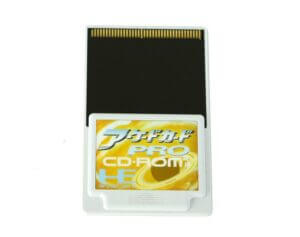
ARCADE CARD DUO: The specific card for owners of the PC Engine Duo, R and RX consoles.
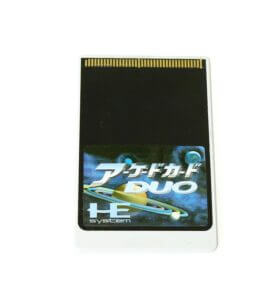
The video games that were released in the ARCADE CD-ROM 2 format were the following, all of them exclusive to Japan (direct translation from Japanese):
- Battlefield ’94 in Tokyo Dome
- Fire Pro Joshi: Shōmu Chōjo Taisen: Zenjo vs. jwp
- Garō Densetsu 2
- Garō Densetsu Special
- Ginga Fukei Densetsu Sapphire
- Janshin Densetsu: Quest of Jongmaster
- Kabuki Ittō Ryōdan
- Mad Stalker: Full Metal Force
- Madō Monogatari I
- Ryūkō no Ken
- Strider Hiryū
- World Heroes 2
The price of the PC Engine, how much did it cost?
Although it may seem the opposite, with the launch of the first PC Engine NEC had no benefit. Launching such a cutting-edge product in those years had a high production cost, the estimation of its developers to be able to obtain benefits with the console placed the initial price at 50,000 yen. Fortunately, the business model they were working with at NEC was the one that Atari imposed with its Atari 2600: Offer a cheap console and profit from the high margins of video games. Also, as HuCards were cheaper to manufacture than cartridges, these margins were even higher on the PC Engine.
Let’s review the prices of the different versions of the PC Engine console launched in Japan, as well as its main competitors, with the aim of being able to contextualize the development of the console throughout its life in the country where it triumphed.
| Nintendo Famicom | 1983 | 14.800 yenes |
| SEGA Mark III | 1985 | 15.000 yenes |
| PC Engine | 1987 | 24.800 yenes |
| SHARP X1 Twin | 1987 | 99.800 yenes |
| SEGA Mega Drive | 1988 | 21.000 yenes |
| PC-KD863G | 1988 | 138.000 yenes |
| PC-Engine Shuttle | 1989 | 18.800 yenes |
| PC Engine Core Grafx, | 1989 | 24.800 yenes |
| PC Engine Super Grafx | 1989 | 39.800 yenes |
| Nintendo Super Famicom | 1990 | 25.000 yenes |
| SNK Neo Geo | 1990 | 58,000 yenes |
| PC Engine GT | 1990 | 44.800 yenes |
| PC Engine Core Grafx II | 1991 | 19,800 yenes |
| PC Engine Duo | 1991 | 59.800 yenes |
| PC Engine LT, | 1991 | 99.800 yenes |
| VICTOR WonderMega | 1992 | 79,800 yenes |
| PC Engine Duo R | 1993 | 39,800 yenes |
| Fujitsu FM TOWNS Marty | 1993 | 98.000 yenes |
| Pioneer LaserActive | 1993 | 89,800 yenes |
| NEC LaserActive | 1993 | 89,800 yenes |
| PC Engine Duo RX | 1994 | 29,800 yenes |
| SNK Neo Geo CD | 1994 | 49,800 yenes |
| SEGA Saturn | 1994 | 44.800 yenes |
| SONY PlayStation | 1994 | 39.800 yenes |
As we can see, the PC Engine broke into the Japanese market as a superior console to Nintendo and SEGA’s 8-bit consoles in every way, including price. As the years passed, the main brands in the sector (Nintendo and Sega) launched products below their price, so NEC had to adapt and launch cheaper versions as well as superior consoles and peripherals, thus covering two audience profiles and broadening the market base. As usual, little by little the system became cheaper until obtaining a console that combined the PC Engine, various extras and CD ROM 2 in 1994, for little more than the original console cost in 1987. Consoles like the PC Engine Duo RX contributed to extend the life of the console before the SNES and the new 32-bit consoles, quite an achievement for a console that was always in the background after Nintendo.
Comparing the prices, we can also see how in very short intervals of just 1 year, the technology advanced and new products were launched at extremely competitive prices, leaving systems with two years of life completely obsolete due to their high prices (which do not provide benefits). If something cannot be discussed with the PC Engine, it is that it knew how to adapt and evolve at all times according to market circumstances, launching products for both the Japanese upper class and the working class and succeeding in the attempt, which is not little seeing against whom it was measured.
PC Engine video game formats
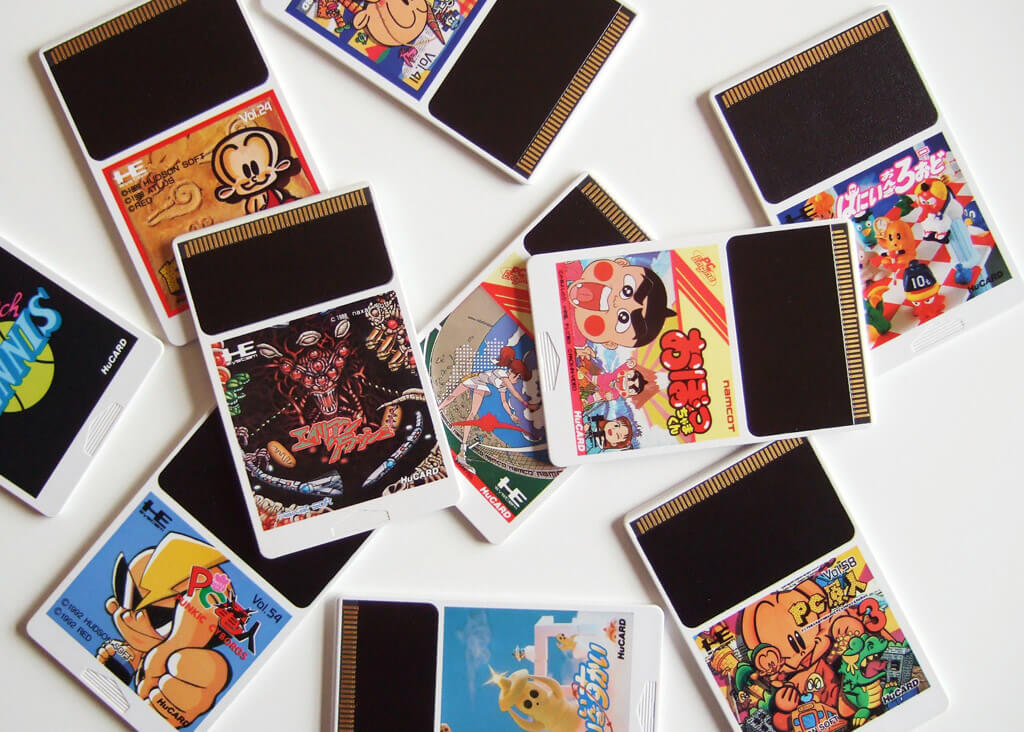
As you can imagine, the PC Engine universe is full of different formats, most of which were compatible with different systems, as long as you had the right peripherals of course. Let’s try to expose it in a simple way showing the different existing formats and their different combinations:
- Format HuCard: It is the original and main format of the console, compatible with all its versions.
- All consoles compatible with the original PC Engine.
- Format SuperGrafx Hucard: It was the format of the 5 video games of the system.
- Only valid for the SuperGrafx console.
- Format CD-ROM 2: The first format devised for CD-ROM 2 released in 1988.
- PC Engine/Core Grafx I y II + CD-ROM 2 + SYSTEM CARD.
- PC Engine/Core Grafx I y II + SUPER CD-ROM 2.
- SuperGrafx + Adaptador CD ROM 2 + CD-ROM 2 + SYSTEM CARD.
- SuperGrafx + SUPER CD-ROM 2.
- PC Engine LT + CD-ROM 2 + SYSTEM CARD.
- PC Engine LT + Adaptador SUPER ROM 2 + SUPER CD-ROM 2.
- PC Engine DUO incluidos R y RX.
- Pioneer y NEC LaserActive + Modulo PC Engine.
- Format SUPER CD-ROM 2: The evolution of CD ROM 2, a new format that required new hardware or extensions, but that allowed more developed video games than its previous versions, as well as a better gaming experience.
- PC Engine/Core Grafx I y II + CD-ROM 2 + SUPER SYSTEM CARD o ARCADE CARD PRO.
- PC Engine/Core Grafx I y II + SUPER CD-ROM 2.
- SuperGrafx + Adaptador CD ROM 2 + CD-ROM 2 + SUPER SYSTEM CARD o ARCADE CARD PRO.
- SuperGrafx + SUPER CD-ROM 2.
- PC Engine LT + Adaptador SUPER ROM 2 + SUPER CD-ROM 2.
- PC Engine DUO incluidos R y RX.
- Pioneer y NEC LaserActive + Modulo PC Engine.
- Format ARCADE: These two cards released in the spring of 1994 raised the memory of our PC Engines by 18 Mbit RAM, making us touch the sky with our hands. 12 video games were released for this format.
- PC Engine/Core Grafx I y II + CD-ROM 2 + ARCADE CARD PRO
- PC Engine/Core Grafx I y II + SUPER CD-ROM 2 + ARCADE CARD PRO
- SuperGrafx + Adaptador CD ROM 2 + CD-ROM 2 + ARCADE CARD PRO
- SuperGrafx + SUPER CD-ROM 2 + ARCADE CARD PRO
- PC Engine LT + Adaptador SUPER CD ROM 2 + SUPER CD ROM 2 + ARCADE CARD PRO
- PC Engine DUO incluidos R y RX + ARCADE CARD DUO
- Pioneer y NEC LaserActive + Modulo PC Engine + ARCADE CARD DUO
Impressive, right? Beautiful and terrifying in equal parts, like a first game of Dark Souls. Actually, the important thing is that in the end NEC supported all its important consoles (with the exception of the Shuttle), launching the necessary peripherals to be able to enjoy a large part of its catalog, even to the buyers of the first console from 1987, something worthy Just smoke it. On the other hand, this is one more example of why I refer to the PC Engine as a system in movement and continuous evolution.
Collect NEC’s PC Engine
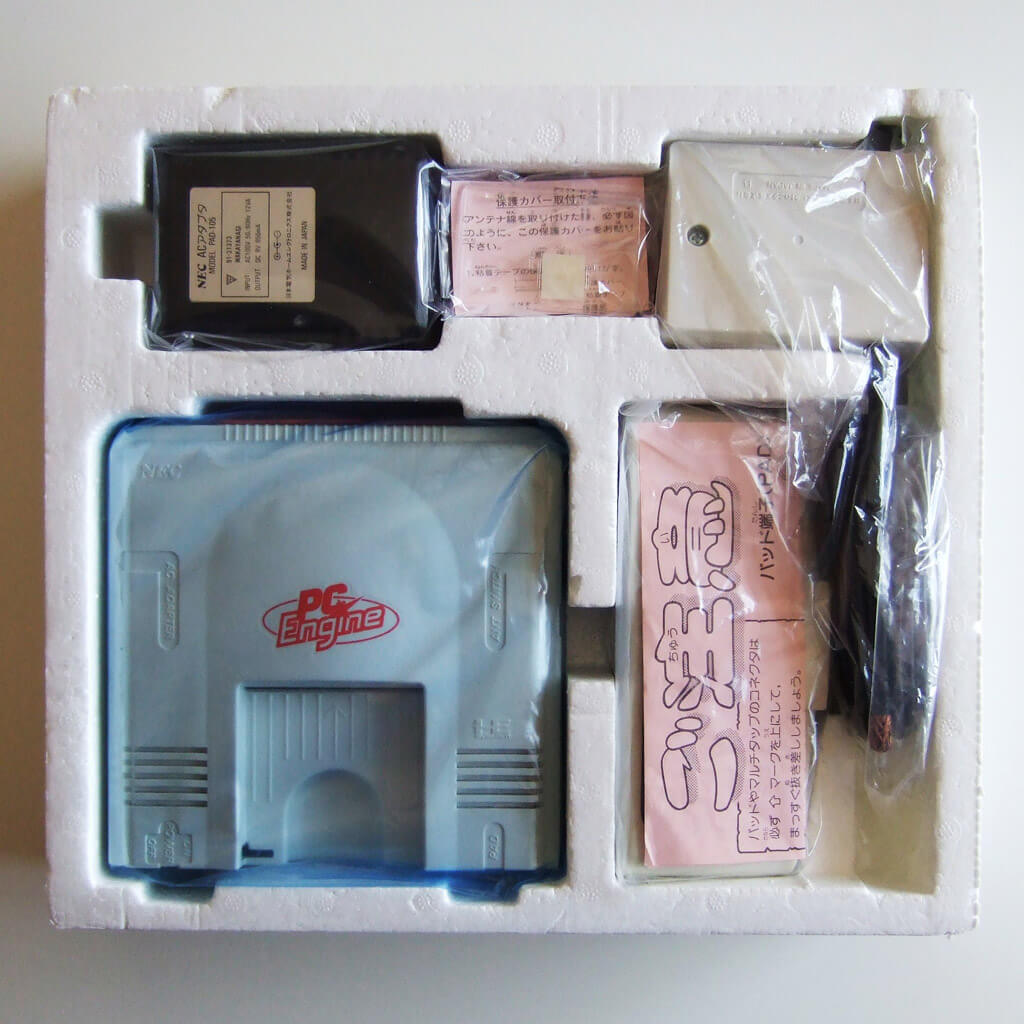
Is the PC Engine worth collecting? Yes, absolutely yes. Some time ago I explained the reasons why the PC Engine is the best retro console to collect, at least for all of us who haven’t been able to enjoy it in its Japanese version, which is the majority of us. And I clarify again that we are talking about the PC Engine, not the TurboGrafx.
PC Engine allows us to collect a 16-bit console with a large catalog to discover for most Westerners, a full 16-bit with all its pixelated and colorful charm, to start enjoying from scratch. To understand each other… It is as if Nintendo or SEGA were re-launching a 16-bit console today, with new 16-bit games… That is what collecting a PC Engine offers us, in the middle of 2020 we still have great consoles to enjoy. Perfection.
Regarding the system, a console as versatile as the PC Engine offers us multiple possibilities: If what interests you are games, go for a PC Engine Duo R or RX without hesitation, with it you will be able to enjoy the vast majority of the catalog. For the more classic players, starting with the first PC Engine or Core Grafx (recommended), can be another slower way of enjoying the HuCards catalog until you decide to make the jump to CD ROM. And for those of us who are specialized in hardware, the PC Engine and all its models is an abysmal challenge that can take up a large part of our time and resources as collectors. We all have our ideal PC Engine.
Regarding video games, today there is a great deal of information on which ones we can play without fear of the language barrier, as well as the first ones to start with. As always, making a list of maximum prices and priorities will help a lot in our search for retro, as well as being another of the pleasures of collecting retro consoles and video games. On the other hand, if you like Shoot ’em ups, the Martians of a lifetime, this is your system, since the PC Engine is a console specialized in this genre of video games.
The price of video games? Being a system that had a remarkable success in Japan, the prices we found are still accessible in most titles (depending on their condition), being possible to get a good representative sample of the system in a few years through the internet. Even so, the truth is that there are fewer and fewer games available, both in specialized Japanese stores and on buying and selling websites, so it will be difficult to get certain titles, unlike what happens with other best-selling consoles. If you are looking for bargains, you can forget unless you can travel to Japan and go hunting for less popular stores, only the shipping costs from Japan already significantly increase the price of video games and in the years that we live with fashion of collecting, bargains are a thing of the past.
Buy a genuine PC Engine
Do you want to buy a PC Engine? The best place to buy a PC Engine online at an acceptable price is eBay, as we have already mentioned from Infoconsolas, we recommend the Core Grafx models if you want the most retro console and focus on HuCards or the PC Engine Duo, R or RX if you are interested in being able to access a large part of the catalog from the beginning. Buying an original PC Engine is a good option only for system purists or collectors, since the video output will give you more than a problem.
The price of the PC Engine? How much does a PC Engine cost? Well, that depends a lot on the state of the console, the box, the instructions… Obviously, consoles like the Turbo Duo or PC Engine Duo make the price more expensive compared to the most basic versions, but it is best that you give yourself a Go back to eBay and look for it yourself, since prices vary a lot from year to year. What is clear is that due to their downward upward trend they will not go down, so don’t take too long!
To make it easier for you, here is an updated selection from eBay with current prices and different PC Engines, I hope you find your PC Engine!:
STOP COLLECTOR! If you’ve seen the console listing on eBay, I want to say THANK YOU. Since 2004, the objective of Infoconsolas is to contribute to preserving the history of consoles and video games through our own collection of systems and the hours of work invested in this very website.
Being an eBay partner listing, if you buy a game or console, you will be helping Infoconsolas in the preservation of video game culture, so thank you very much again!
TOP: Best NEC PC Engine Console Games
Let’s clarify this point from the beginning, I would be lying if I presented you with an impartial and objective PC Engine TOP, it would not be true for a simple reason: The language barrier makes many titles unattainable for me and for the majority of the general public especially RPGs. Having a large percentage of games that I don’t have access to because I don’t speak Japanese, I can’t pretend to make such a biased TOP of a Japanese console… But fortunately the PC Engine catalog is gigantic and, with more than 600 games published, there are many games completely accessible to us, so my intention is to make a TOP of the most representative games of the system in which the language barrier is not a problem:
Soldier Blade
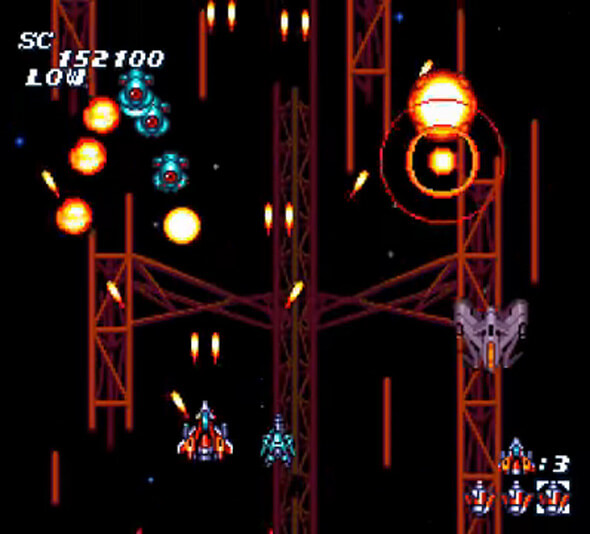
1992, Hudson Soft
Formato: HuCard
We start with the genre that best characterizes the PC Engine, the Shoot ’em up, the lifelong Martians that we were saying here. Soldier Blade is a Japan exclusive, the fourth and final title in the Star Soldier saga released on the NEC console. A sample of what the base console and a HuCard was capable of.
PC Genjin 3 / Bonk 3: Bonk’s Big Adventure
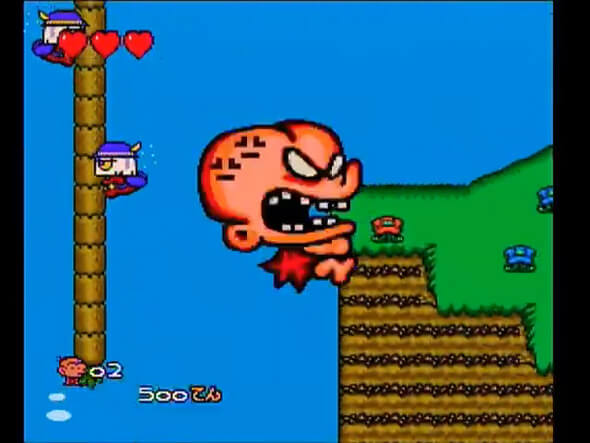
1993, Hudson Soft
Formato: HuCard
Developed by A.I Co., Ltd and distributed by Hudson Soft, the third part of what is considered the mascot of the PC Engine, concentrated the entire universe of the saga in a 1MB HuCard. One of the most sought after system games published in Japan and the West today.
Bomberman
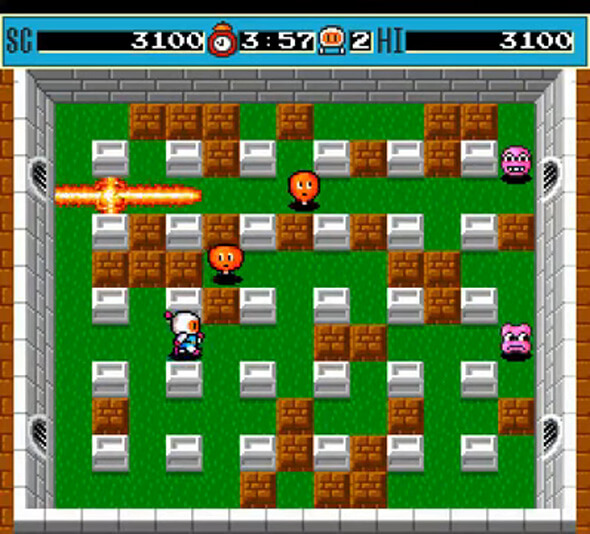
1991, Hudson Soft
Formato: HuCard
The first Bomberman that was released for the NEC console of the 4 that it had. Curious that we enjoyed this game many years before on other systems, but to redeem themselves they offered us a reimagined version with quite a few modifications compared to the original title. It should be noted at this point that «reimagining» or «reinterpreting» certain games adapting them to the benefits of the PC Engine, to show the differences with respect to 8-bit consoles, was something very common in the NEC console.
Street Fighter II´ Champion Edition
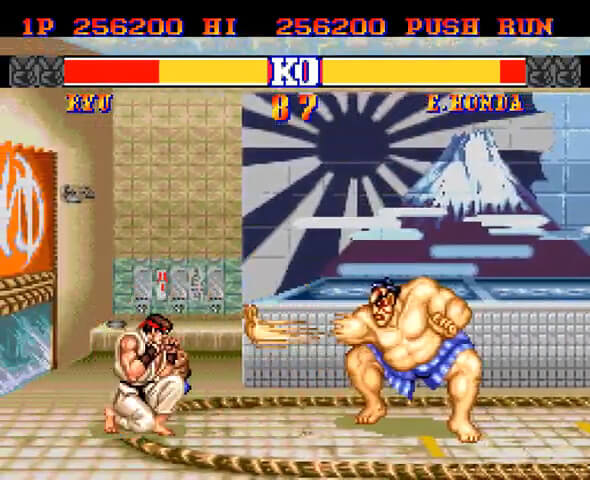
1993, NEC Home Electronics / CAPCOM
Formato: HuCard
Big words. A Japan exclusive, for many the best conversion of the arcade to a home console that has ever been made, the game that shows how far a 1987 console could go without any peripherals or expansions, just the PC Engine and a HuCard of nothing more and nothing less than 20 Mb… IMPRESSIVE. Interestingly, the first PC Engine Street Fighter called Fighting Street was released in CD ROM format, so it looked like CD ROM would be the format of choice again. Fortunately, to cut load times and reach a larger audience, the HuCard won the day.
R-Type
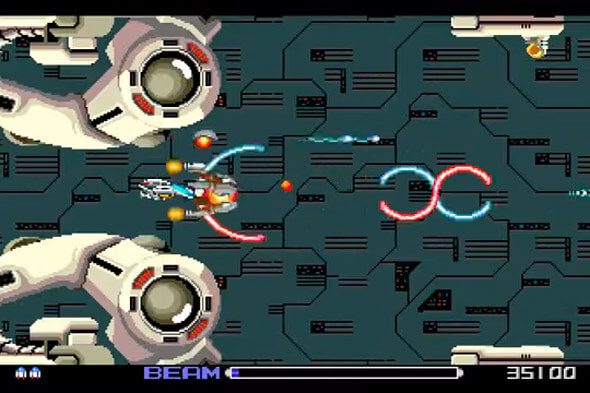
1988, Hudson Soft / IREM
Formato: HuCard
Although there is a later complete version in CD format, I have chosen the first R-Type due to the importance of this title in the PC Engine console, the R-Type was a console seller that showed that the NEC machine was perfectly capable of carrying a arcade star game, to the small PC Engine. A hit on the table that showed the differences between the NES and the PC Engine, just as its creators had planned. The game? The game is a work of art, a must for anyone who loves this hobby, that of video games.
The Legendary Axe
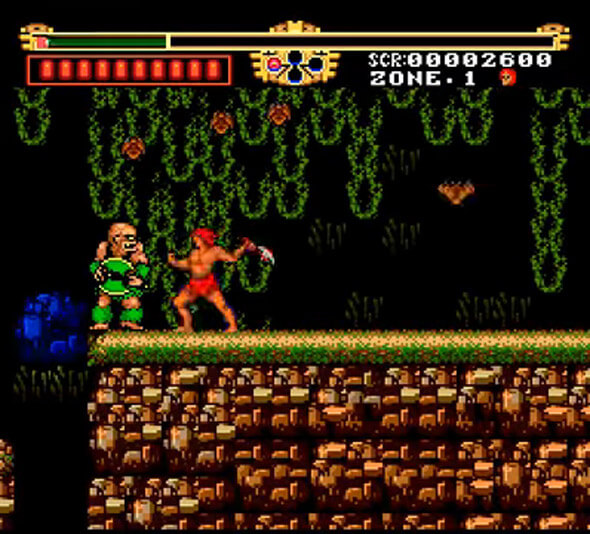
1988, NEC / VICTOR
Formato: HuCard
Released both in Japan and in the West, The Legendary Ax received very good reviews from the specialized press of the time, being considered by many an evolution of the mythical Rastan. In practice, it is a remarkable game accessible to all without any language penalty.
Dragon Spirit

1988, Namcot
Formato: Hucard
Released in both Japan and the West a year later, this popular title is a great conversion of Namco’s own 1987 arcade game, being ported to many systems of the time. Its reception was very positive due to its innovative nature compared to other shoot ’em ups, its mechanics being very similar to Xevius, attacking both air and ground targets with different weapons.
Neutopia II
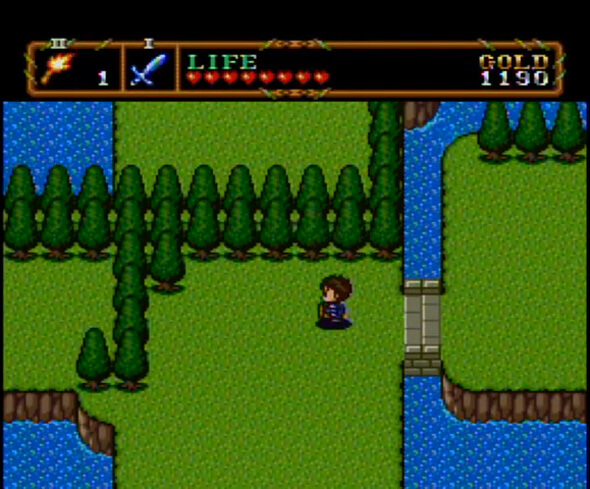
1991, Hudson Soft /TTI
Formato: HuCard
Considered the Zelda of the PC Engine, this game is one of the few of its kind that made it to the West, an RPG with a lot of action and little text accessible to most players. Over the years, criticism of the game has improved, and today it is a must-have for most PC Engine collectors.
After Burner
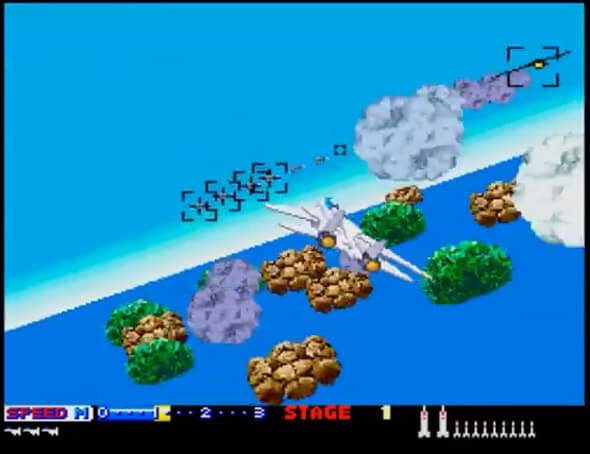
1990, NEC / SEGA
Formato: HuCard
Yes, Sega also brought its arcade games to the PC Engine even though it was a direct competitor of its MegaDrive. In this case, After Burner II shows us how, without specific chips like other consoles, the PC Engine was capable of emulating more advanced system effects and modes through programming and brute force in a splendid way. Little to envy the 16-bit SEGA and one of the few video games of this genre that was launched on the NEC console.
Parodius Da!
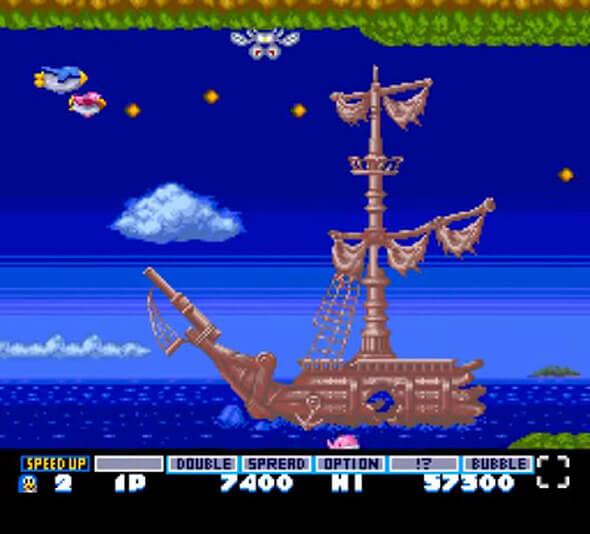
1992, Konami
Formato: HuCard
Hudson, NEC, and Konami had preferential negotiations and deals that benefited all three companies. Relationships were excellent and Konami had many advantages in publishing their games on the PC Engine system compared to other third parties. Parody Da! is just one example of the many Konami games that were released on the NEC console, in this case being a benchmark of the genre.
Parasol Stars: The Story of Bubble Bobble III
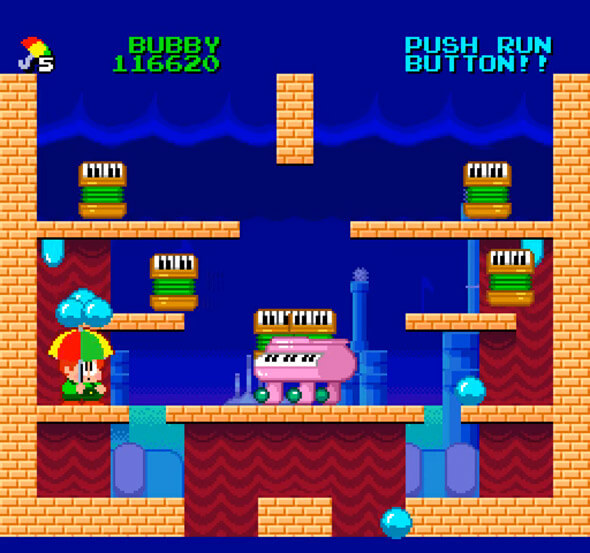
1991, TAITO
Format: HuCard
Parasol Star, launched by TAITO in 1991 for both the Japanese and Western markets, is neither more nor less than the third part of the mythical Bubble Bobble, an addictive game that preserves all the magic and playability of the saga in magnificent settings full color and its aesthetic characteristic.
Air Zonk
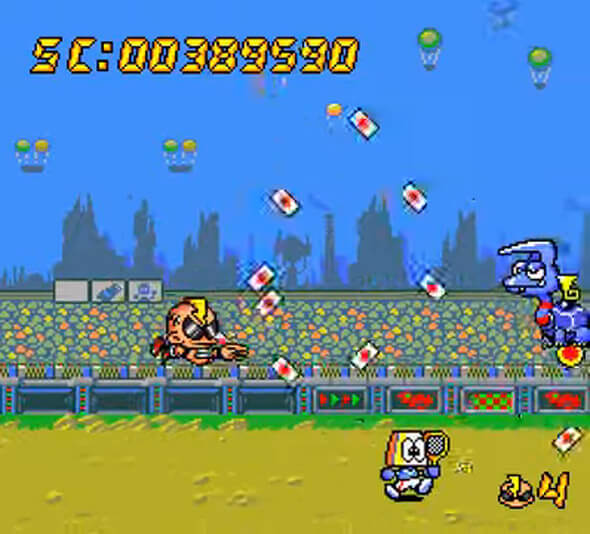
1992, Hudson Soft / TTI
Format: HuCard
One of the few games that was released earlier on the North American system than on the Japanese one. In October 1992, Hudson surprised us with this futuristic version of Bonk/PC Kid, taking his character to the genre that the PC Engine was best at, Shoot ’em up. A visual and playable delight with the characteristic humor of the saga that would later make the leap in its sequel to the Super CD-ROM².
Gate of Thunder
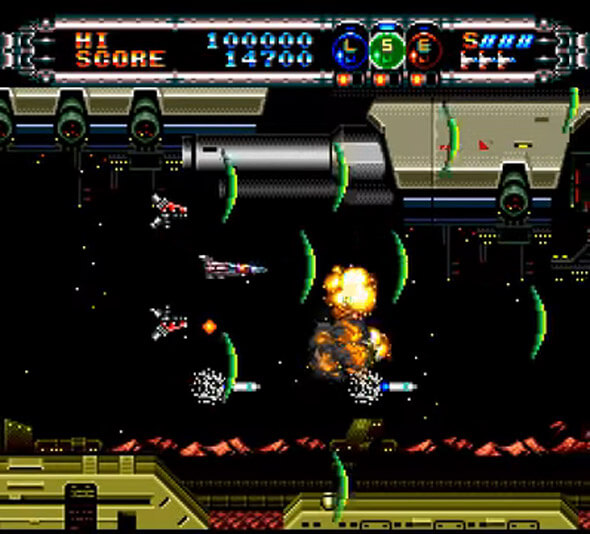
1992, Hudson Soft / TTI
Format: Super CD-ROM²
A great shooter that in this case was also published outside of Japan, forming part of one of the packs that were sold with the TurboGrafx in the United States, accompanied by the video games Bonk’s Adventure, Bonk’s Revenge, and Bomberman. Received with very good reviews by the specialized press of the time, it is essential to make special mention of its successful cinematics.
Cotton: Fantastic Night Dreams
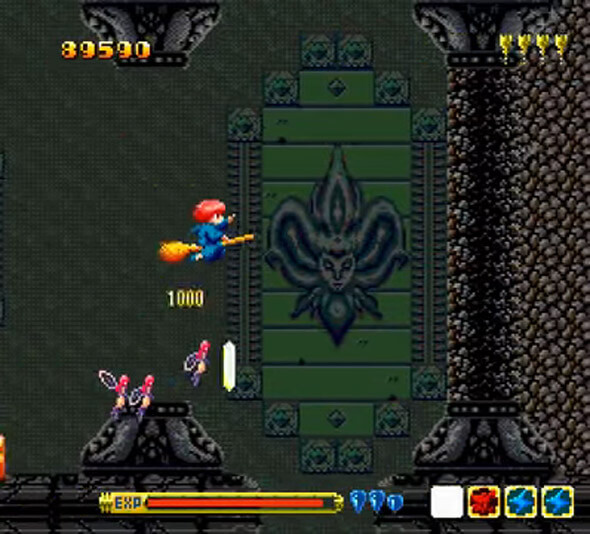
1993, TTI
Format: Super CD-ROM²
A magnificent cute ’em up, which basically means that it is a traditional shoot ’em ups but much more beautiful. Aesthetics aside, it is another perfect example of how well the old Martians suited the PC Engine, in this case a worthy conversion of the SEGA arcade game and its SEGA System 16 board, in which only the resolution was lowered and the color palette was modified… A beast this PC Engine with the Super CD-ROM².
Mr Heli no Daibouken
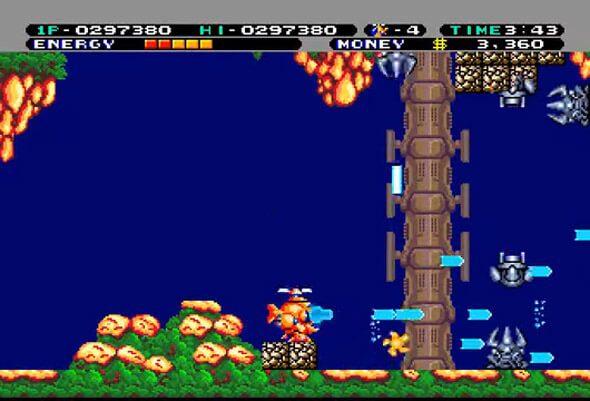
1989, IREM
Formato: HuCard
Another exclusivity of the Japanese market in which the guys from IREM, a company that didn’t know how to make a bad game, put us at the controls of a mining helicopter in a perfect conversion of the arcade game. In the West we would have to make do with its arcade version called Battle Chopper.
Akumajō Dracula X: Chi no Rondo
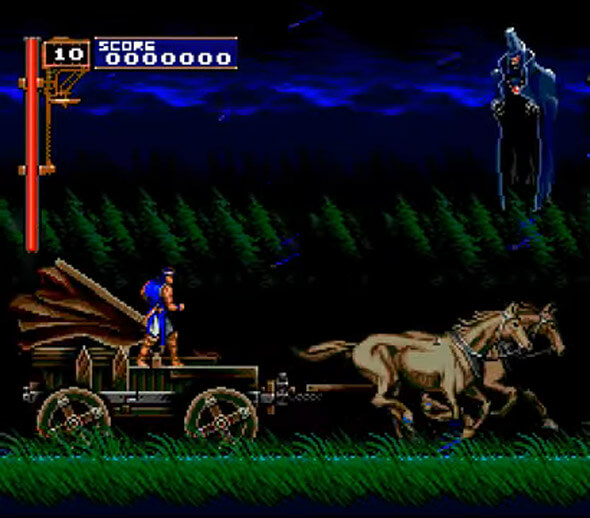
1993, KONAMI
Format: Super CD-ROM²
The tenth installment in chronological order of Konami’s well-known saga, Akumajō Dracula, arrived on the PC Engine to become a masterpiece from day one. The CD-ROM gave the Castlevania saga some crazy technical features and animations, establishing it as one of the best games in the saga of all time. As a curiosity, it was the first title of the saga in which it could be saved, quite an evolution.
Dragon Ball Z: Idainaru Son Gokou Densetsu

1994, BANDAI
Format: Super CD-ROM²
Possibly the best Dragon Ball of all time in relation to its time. When the Dragon Ball universe had made the leap from Japanese RPGs to 1vs1 fighting games on the Snes and MegaDrive, Bandai published a Dragon Ball ahead of its time and with a sublime approach: A review of the entire history of Dragon Ball through new cinematic and with very long fights (as in the series) against the most relevant characters, from Tao Pai Pai to Cellula.
A perfect example of how to take advantage of a storage format like CD ROM. Unfortunately and of course, it was exclusive to Japan, but you can still get it through the usual 2nd hand channels. In my case, I found it at a very good price at Mr. Potato in Osaka, Japan (which is cheaper than in Tokyo)… In other words, there are still units for sale.
And so far the selection of the best PC Engine video games. There are many more that could be here, I know and that is a huge positive, but I have chosen these. On the other hand, you will notice that I have incorporated many more titles from HuCard than from CD ROM. Obviously, CD ROM games are usually visually superior, with better cinematics and audio as well as being more extensive, but I prefer to expose the titles that stand out from the base system, understanding that it is the one that all present or future owners have in common. The best PC Engine CD ROM2 games or specific to their variants? We’d better leave that for another article…
Regarding the region of the titles, when dealing with this analysis of the PC Engine console and not the TurboGrafx, you will see that I have focused mainly on Japanese games, although in some cases, as you have seen, they were also published in the West for the TurboGrafx. As I have already mentioned, my intention in this section is none other than to capture the many good options that Westerners have to have fun with a 100% Japanese console.
FAQ PC Engine
A console like the PC Engine, which is a video game universe in itself, raises many questions for collectors and fans of retro. At this point we will try to solve the most frequently asked questions about the PC Engine and its different versions:
Not counting clones and Korean versions, there are 12 compatible PC Engine versions made by NEC and 3 more by other manufacturers.
On October 30, 1987, in Japan
It cost 24,800 yen.
687 officers.
277 games.
110 games.
253 games.
There were two, Bikkuriman World, an arcade adaptation of Wonder Boy: Monster Land, and Shanghai, both released on October 30, 1987 by Hudson Soft.
Tengai Makai II Swastika MARU, with more than 500,000 units sold.
The last video game in Hu Card format was “21エモン めざせホテル王”, released on December 16, 1994 in Japan.
It is a HuCard compatible with the PC Engine and Supergrafx, which when running on a Supergrafx inserted certain additions in the game, only one game with these characteristics was released.
Together, between the 4 models, 920,000 units were sold worldwide.
The Super Grafx, with the SUPER CD ROM 2 + the Arcade Pro card, which today costs something like selling your mother.
Only two PC Engine GT (Turbo Express) can be connected with their corresponding link cable, each one with its corresponding game. To checkout…
Normally the tracks on the CD are as follows: 1st WARNING (playable), 2nd GAME DATA (Unplayable), 3rd and later Game BGM (playable), last DATA track unplayable.
No, they are not compatible.
Yes, but only with the corresponding adapter.
Yes, even different memory expansion cards are compatible with the adapter.
6 AA batteries last about 3 hours of play. A sloth…
There are PC Engine family models for which peripherals such as “Duo battery” and a portable LCD monitor called “Duo monitor” (a foldable portable monitor with Duo aesthetics) were released, so you can play anywhere.
This is what CD-ROM2 and SUPER CD-ROM2 are commonly called.
Technical characteristics of the PC Engine video game console
- CPU: HuC6280 (built-in sound source)
Clock: 1.79 MHz / 7.16 MHz (software selectable). A custom CPU with its own instructions added to the MOS 6502 compatible CPU. The clock frequency is 7.16 MHz, which is four times the Famicom’s operating frequency of 1.79 MHz.
- VDC (Video Display Controller): HuC6270
- VCE (Video Color Encoder): HuC6260
- Main RAM: 8KB
- VRAM: 64KB (32KB + 32KB)
Screen resolution (pixels)
- 256 x 240
- 320 x 240 (N / A)
- 336 x 240
- 512 x 240
Approximately 224 lines are within the TV’s display range. The number of pixels in the horizontal direction can be arbitrarily changed from 256, 336 and 512. VDC (HuC6270), it has a 16-bit register and can handle 512 horizontal coordinates without any problem. There is not enough VRAM capacity to display a graph created in pixel units with 512 pixels horizontal, but it can be displayed using the BG display. Simultaneous color development up to 512 colors. Pallet Sprite 16 + 1, without pallet on the BG side. Sprite 15 x 256 colors at 16 x 16 dots + transparent color, BG: 16 of 256 colors at 8 x 8 dots. When outputting NTSC signals, it is possible to cut off the color burst signal and display in monochrome.
Sprites
- Up to 64 (1 sprite size is from 16 x 16 to 32 x 64 color designation 15 colors out of 256 colors + transparent color)
- The maximum size of 16 x 16 in the horizontal direction is 16 (limited to 14 in 320 point landscape mode). This is overclocked when 16 sprites are arranged side by side. Since correct operation of the PC Engine cannot be guaranteed, it was configured in accordance with NEC guidelines.
Background (BG screen) 1 screen (1 character is fixed at 8 x 8 pixels and a maximum of 2048 is defined. 16 colors out of 256 colors are specified)
- Technical characteristics obtained from wikipedia.
External sources and links
- Famitsu magazine
- https://www.gamepres.org/2016/02/26/pcengine/
- http://m.gametoc.hankyung.com/news/articleView.html?idxno=54910
- https://necretro.org/
- Console graphic resources:
- https://commons.wikimedia.org/wiki/User:Evan-Amos
- https://www.cafr.ebay.ca/
- https://smartmart-shop.com/
- https://www.flickr.com/photos/bochalla/

